Paul van Yperen's Blog, page 330
October 19, 2016
Pierce Brosnan
Irish film and television actor and film producer Pierce Brosnan (1953) is best known for his recurring role as British spy 007 in the popular James Bond film series. He first won over television audiences in the detective series Remington Steele (1982-1987). Outside of Bond, Brosnan is known for big-screen performances in Mrs. Doubtfire (1993), The Thomas Crown Affair (1999) and Laws of Attraction (2004).
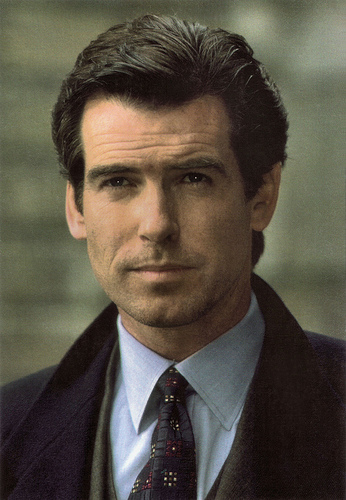
American postcard by Classico, San Francisco, no. 105-454. Photo: Danjaq / United Artists Corporation / Eon Productions / Mac B. Photo: publicity still for Goldeneye (Martin Campbell, 1995).

French postcard by Sonis, no. C. 609. Photo: Danjaq and United Artists Corporation. Photo: publicity still for Goldeneye (Martin Campbell, 1995) with Famke Jansen and Isabella Scoruppo.
Remington Steele
Pierce Brendan Brosnan was born in Drogheda, County Louth, Ireland in 1953. He was the only child of Thomas Brosnan, a carpenter, and May Brosnan née Smith. Brosnan's father abandoned the family when Pierce was an infant. When he was four years old, his mother moved to London to work as a nurse. From that point on, he was largely brought up by his grandparents. After their deaths, he lived with an aunt and then an uncle, but was subsequently sent to live in a boarding house.
Brosnan left Ireland in 1964 and was reunited with his mother and her new husband, William Carmichael. Carmichael took the 11-years-old Pierce to see a James Bond film for the first time, Goldfinger (Guy Hamilton, 1964). At the age of 16, Brosnan left comprehensive school and began a training in commercial illustration at at Saint Martin's School of Art. He joined an experimental theater group (some sources say a circus) and studied at the Drama Centre London.
He made his acting debut in the play Wait Until Dark. Within six months, he was selected by playwright Tennessee Williams to play the role of McCabe in the British première of The Red Devil Battery Sign. In 1977 he was picked by Franco Zeffirelli to appear in the play Filumena by Eduardo De Filippo opposite Joan Plowright.
He also played small roles in films like The Long Good Friday (John Mackenzie, 1980) with Bob Hoskins, and the Agatha Christie mystery The Mirror Crack'd (Guy Hamilton, 1980), starring Angela Lansbury as Miss Marple. After more stage roles in London, he moved to Los Angeles, where he made his American debut in the TV Mini-series The Manions of America (Joseph Sargent, 1981), about Irish immigrants to the United States during the Great Famine of the mid-19th century. He followed this with the Mini-series Nancy Astor (1982), which chronicled the life of Lady Nancy Astor, the first woman to sit in British Parliament. His portrayal of Robert Gould Shaw II garnered him a 1985 Golden Globe Award nomination for Best Supporting Actor.
Then he was offered the lead in the detective series Remington Steele (1982-1987). The series blended the genres of romantic comedy, drama, and detective procedural, and Brosnan won over the American public with his good looks and charm. Biography.com : “Viewers tuned in to catch the show's latest mystery and watch the sparks fly between the two lead characters, played by Brosnan and his co-star, Stephanie Zimbalist.”
In 1986, he received an offer to play British spy James Bond in the footsteps of Sean Connery , George Lazenby and Roger Moore . Brosnan tried to get out of his contract for Remington Steele, but to no avail. The TV series ended the following year. In the late 1980s, Brosnan acted in several television and film projects, including the Cold War spy film The Fourth Protocol (John Mackenzie, 1987) with Michael Caine , the TV miniseries Around the World in 80 Days (Buzz Kulik, 1989) with Brosnan as Phileas Fogg and Eric Idle as Passepartout, the horror film The Lawnmower Man (Brett Leonard, 1992), and the comedy smash Mrs. Doubtfire (Chris Columbus, 1993) featuring Robin Williams.
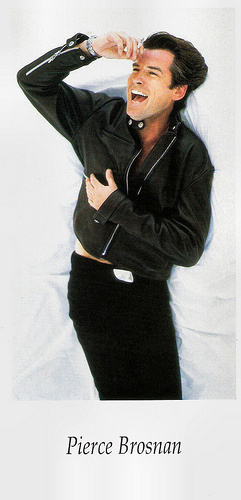
Dutch postcard by MutiChoice Kaleidoscope. Photo: Isopress / Outline (Sanchez).
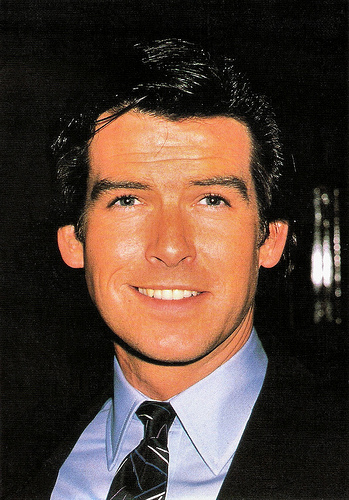
British postcard by Heroes, London, no. 1SPC 2801.
James Bond
In 1995, Pierce Brosnan finally secured a role as the legendary James Bond in Goldeneye (Martin Campbell, 1995), replacing Timothy Dalton . In the film, Bond fights to prevent an ex-MI6 agent (Sean Bean), gone rogue, from using a satellite against London to cause global financial meltdown. The film accumulated a worldwide gross of US$ 350.7 million, considerably better than Dalton's films.
Brosnan played Bond three more times, in Tomorrow Never Dies (Roger Spottiswoode, 1997) with Jonathan Pryce, The World is Not Enough (Michael Apted, 1999) with Sophie Marceau, and Die Another Day (Lee Tamahori, 2002) with Halle Berry. Die Another Day was the highest-grossing James Bond film up to that time. After starring in these four James Bond films, Brosnan decided it was time to pass the baton. Actor Daniel Craig took over the part in Casino Royale (2006).
In 1996, Brosnan formed a film production company entitled Irish DreamTime along with producing partner and longtime friend Beau St. Clair. Their first production was The Nephew (Eugene Brady, 1998), followed by the critical and box office success The Thomas Crown Affair (John McTiernan, 1999).
While playing 007, Brosnan also starred in the hilarious spoof Mars Attacks! (Tim Burton, 1996), the disaster thriller Dante's Peak (Roger Donaldson, 1997), and starred in the John le Carré adaptation The Tailor of Panama (John Boorman, 2001), with Jamie Lee Curtis and Geoffrey Rush. In 2001, Brosnan became an Ambassador for UNICEF Ireland. He also raises money for charitable causes through sales of his paintings, and is active as an environmentalist.
Since leaving the Bond franchise, he starred in both dramas and comedies, such as Laws of Attraction (Peter Howitt, 2004) alongside Julianne Moore, the film adaption of the ABBA musical Mamma Mia! (Phyllida Lloyd, 2008) with Meryl Streep, Roman Polanski’s political thriller The Ghost Writer (2010), playing a disgraced British Prime Minister, and the action spy thriller The November Man (Roger Donaldson, 2014). For his part in the dark comedy The Matador (Richard Shepard, 2005), he won a Golden Globe nomination.
Pierce Brosnan has been married twice. His first marriage to actress Cassandra Harris lasted from 1980 until her death in 1991. He adopted her two children, Charlotte and Christopher, and the couple had a son together, Sean. In 2001, Brosnan married Keely Shaye. They have two children together, Paris and Dylan.
In 2016 Pierce Brosnan filmed The Foreigner in London, co-starring with Jackie Chan. He plays a former IRA man turned government official Liam Hennessy. The film is directed by Martin Campbell, the director of Brosnan’s Bond debut, GoldenEye (1995). After that, he filmed in Versailles the American adventure The King's Daughter (Sean McNamara, 2016), with Brosnan as King Louis XIV. Soon in a theatre near you.
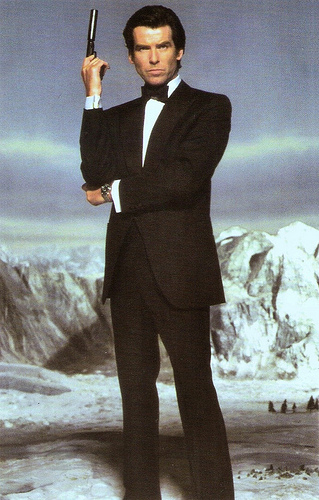
American postcard by Classico, San Francisco, no. 105-454. Photo: Danjaq / United Artists Corporation / Eon Productions / Mac B. Photo: publicity still for Goldeneye (Martin Campbell, 1995). (The edges for this postcard were cut off.)
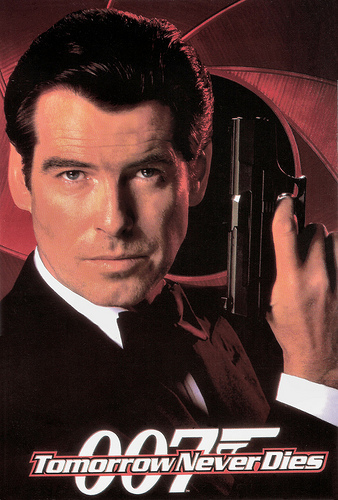
American postcard by Classico, San Francisco, no. 110-108. Photo: Danjaq / LLC / United Artists Corporation / Eon. Publicity still for Tomorrow Never Dies (Roger Spottiswoode, 1997). (The edges of this postcard were cut off).
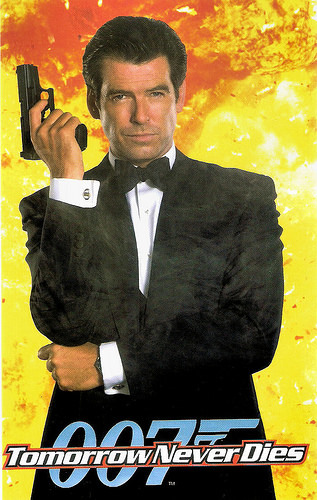
British postcard by London Postcard Company. Photo: Danjaq / LLC / United Artists Corporation / Eon. Publicity still for Tomorrow Never Dies (Roger Spottiswoode, 1997). (The edges of this postcard were cut off).
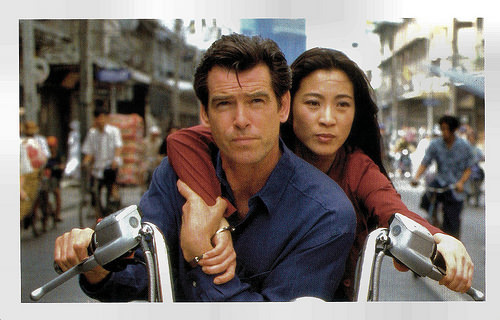
British postcard by Danjaq, LLC and United Artists Corporation. Photo: publicity still for Tomorrow Never Dies (Roger Spottiswoode, 1997) with Michelle Yeoh.
Sources: Biography.com, Wikipedia and .

American postcard by Classico, San Francisco, no. 105-454. Photo: Danjaq / United Artists Corporation / Eon Productions / Mac B. Photo: publicity still for Goldeneye (Martin Campbell, 1995).

French postcard by Sonis, no. C. 609. Photo: Danjaq and United Artists Corporation. Photo: publicity still for Goldeneye (Martin Campbell, 1995) with Famke Jansen and Isabella Scoruppo.
Remington Steele
Pierce Brendan Brosnan was born in Drogheda, County Louth, Ireland in 1953. He was the only child of Thomas Brosnan, a carpenter, and May Brosnan née Smith. Brosnan's father abandoned the family when Pierce was an infant. When he was four years old, his mother moved to London to work as a nurse. From that point on, he was largely brought up by his grandparents. After their deaths, he lived with an aunt and then an uncle, but was subsequently sent to live in a boarding house.
Brosnan left Ireland in 1964 and was reunited with his mother and her new husband, William Carmichael. Carmichael took the 11-years-old Pierce to see a James Bond film for the first time, Goldfinger (Guy Hamilton, 1964). At the age of 16, Brosnan left comprehensive school and began a training in commercial illustration at at Saint Martin's School of Art. He joined an experimental theater group (some sources say a circus) and studied at the Drama Centre London.
He made his acting debut in the play Wait Until Dark. Within six months, he was selected by playwright Tennessee Williams to play the role of McCabe in the British première of The Red Devil Battery Sign. In 1977 he was picked by Franco Zeffirelli to appear in the play Filumena by Eduardo De Filippo opposite Joan Plowright.
He also played small roles in films like The Long Good Friday (John Mackenzie, 1980) with Bob Hoskins, and the Agatha Christie mystery The Mirror Crack'd (Guy Hamilton, 1980), starring Angela Lansbury as Miss Marple. After more stage roles in London, he moved to Los Angeles, where he made his American debut in the TV Mini-series The Manions of America (Joseph Sargent, 1981), about Irish immigrants to the United States during the Great Famine of the mid-19th century. He followed this with the Mini-series Nancy Astor (1982), which chronicled the life of Lady Nancy Astor, the first woman to sit in British Parliament. His portrayal of Robert Gould Shaw II garnered him a 1985 Golden Globe Award nomination for Best Supporting Actor.
Then he was offered the lead in the detective series Remington Steele (1982-1987). The series blended the genres of romantic comedy, drama, and detective procedural, and Brosnan won over the American public with his good looks and charm. Biography.com : “Viewers tuned in to catch the show's latest mystery and watch the sparks fly between the two lead characters, played by Brosnan and his co-star, Stephanie Zimbalist.”
In 1986, he received an offer to play British spy James Bond in the footsteps of Sean Connery , George Lazenby and Roger Moore . Brosnan tried to get out of his contract for Remington Steele, but to no avail. The TV series ended the following year. In the late 1980s, Brosnan acted in several television and film projects, including the Cold War spy film The Fourth Protocol (John Mackenzie, 1987) with Michael Caine , the TV miniseries Around the World in 80 Days (Buzz Kulik, 1989) with Brosnan as Phileas Fogg and Eric Idle as Passepartout, the horror film The Lawnmower Man (Brett Leonard, 1992), and the comedy smash Mrs. Doubtfire (Chris Columbus, 1993) featuring Robin Williams.

Dutch postcard by MutiChoice Kaleidoscope. Photo: Isopress / Outline (Sanchez).

British postcard by Heroes, London, no. 1SPC 2801.
James Bond
In 1995, Pierce Brosnan finally secured a role as the legendary James Bond in Goldeneye (Martin Campbell, 1995), replacing Timothy Dalton . In the film, Bond fights to prevent an ex-MI6 agent (Sean Bean), gone rogue, from using a satellite against London to cause global financial meltdown. The film accumulated a worldwide gross of US$ 350.7 million, considerably better than Dalton's films.
Brosnan played Bond three more times, in Tomorrow Never Dies (Roger Spottiswoode, 1997) with Jonathan Pryce, The World is Not Enough (Michael Apted, 1999) with Sophie Marceau, and Die Another Day (Lee Tamahori, 2002) with Halle Berry. Die Another Day was the highest-grossing James Bond film up to that time. After starring in these four James Bond films, Brosnan decided it was time to pass the baton. Actor Daniel Craig took over the part in Casino Royale (2006).
In 1996, Brosnan formed a film production company entitled Irish DreamTime along with producing partner and longtime friend Beau St. Clair. Their first production was The Nephew (Eugene Brady, 1998), followed by the critical and box office success The Thomas Crown Affair (John McTiernan, 1999).
While playing 007, Brosnan also starred in the hilarious spoof Mars Attacks! (Tim Burton, 1996), the disaster thriller Dante's Peak (Roger Donaldson, 1997), and starred in the John le Carré adaptation The Tailor of Panama (John Boorman, 2001), with Jamie Lee Curtis and Geoffrey Rush. In 2001, Brosnan became an Ambassador for UNICEF Ireland. He also raises money for charitable causes through sales of his paintings, and is active as an environmentalist.
Since leaving the Bond franchise, he starred in both dramas and comedies, such as Laws of Attraction (Peter Howitt, 2004) alongside Julianne Moore, the film adaption of the ABBA musical Mamma Mia! (Phyllida Lloyd, 2008) with Meryl Streep, Roman Polanski’s political thriller The Ghost Writer (2010), playing a disgraced British Prime Minister, and the action spy thriller The November Man (Roger Donaldson, 2014). For his part in the dark comedy The Matador (Richard Shepard, 2005), he won a Golden Globe nomination.
Pierce Brosnan has been married twice. His first marriage to actress Cassandra Harris lasted from 1980 until her death in 1991. He adopted her two children, Charlotte and Christopher, and the couple had a son together, Sean. In 2001, Brosnan married Keely Shaye. They have two children together, Paris and Dylan.
In 2016 Pierce Brosnan filmed The Foreigner in London, co-starring with Jackie Chan. He plays a former IRA man turned government official Liam Hennessy. The film is directed by Martin Campbell, the director of Brosnan’s Bond debut, GoldenEye (1995). After that, he filmed in Versailles the American adventure The King's Daughter (Sean McNamara, 2016), with Brosnan as King Louis XIV. Soon in a theatre near you.

American postcard by Classico, San Francisco, no. 105-454. Photo: Danjaq / United Artists Corporation / Eon Productions / Mac B. Photo: publicity still for Goldeneye (Martin Campbell, 1995). (The edges for this postcard were cut off.)

American postcard by Classico, San Francisco, no. 110-108. Photo: Danjaq / LLC / United Artists Corporation / Eon. Publicity still for Tomorrow Never Dies (Roger Spottiswoode, 1997). (The edges of this postcard were cut off).

British postcard by London Postcard Company. Photo: Danjaq / LLC / United Artists Corporation / Eon. Publicity still for Tomorrow Never Dies (Roger Spottiswoode, 1997). (The edges of this postcard were cut off).

British postcard by Danjaq, LLC and United Artists Corporation. Photo: publicity still for Tomorrow Never Dies (Roger Spottiswoode, 1997) with Michelle Yeoh.
Sources: Biography.com, Wikipedia and .
Published on October 19, 2016 22:00
October 18, 2016
La Wally (1932)
Italian stage and screen actress Germana Paolieri featured as Wally (German Paolieri), the most beautiful girl in the town of Sölden in Tyrol, in La Wally (1932). This early Italian sound film, based on the opera by Alfredo Catalani, offered lots of singing and heavy acting, snowstorms, fathomless depths, dark woods on the slopes, waterfalls, and capricious skies over Southern Tyrol.
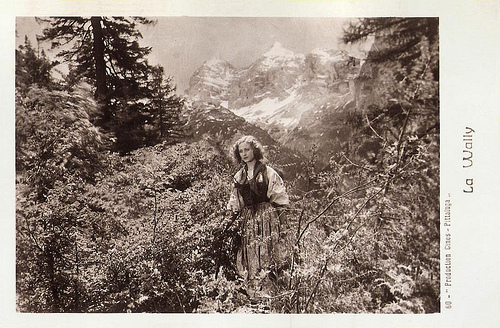
Italian postcard by G.B. Falci, Milano, no. 60. Photo: Cines-Pittaluga. Publicity still for La Wally (Guido Brignone, 1932), starring Germana Paolieri as Wally.
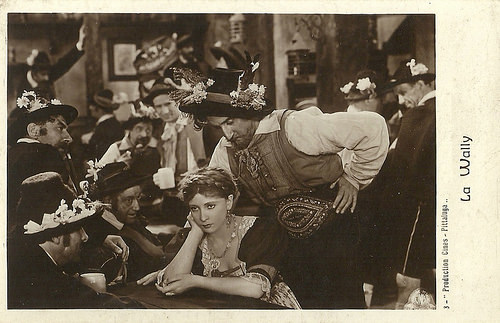
Italian postcard by G.B. Falci, Milano, no. 3. Photo: Cines-Pittaluga. Publicity still for La Wally (Guido Brignone, 1932), co-starring Carlo Ninchi and Isa Pola .
A love obstructed
Wally ( Germana Paolieri ) loves bear hunter Hagenbach ( Carlo Ninchi ), but their love is obstructed by all close to them.
A rival lover, Vincenzo Gellner (Renzo Ricci) plots to set up Wally’s father Stromminger (Achille Majeroni) against Hagenbach, and an old feud between the old man and the young one restarts. In the village inn the two get into a fight, after which Wally’s is chased from her house and flees into the mountains.
A year passes, Stromminger dies and Wally inherits his fortune, while Hagenbach engages to Afra ( Isa Pola ). At the next Spring party in Sölden, both Hagenbach and Wally attend. Hagenbach’s friends bet he cannot kiss his former girlfriend but Hagenbach wins.
Yet, when Wally finds out she has been the object of a bet, she hates Hagenbach. She even pushes rival Gellner to kill Hagenbach, but she repents and saves him, lifting him unconscious from a ravine.
Wally hides in a cabin where her lover Hagenbach comes to ask for forgiveness. She also confesses and the two reunite. The film ends tragically though. Hagenbach dies because of an avalanche and out of despair Wally throws herself into the ravine.
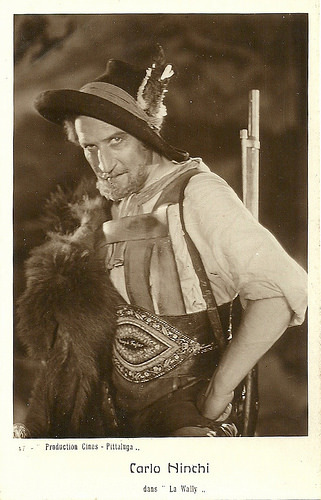
Italian postcard with French text by G.B. Falci, Milano, no. 47. Photo: Cines-Pittaluga. Publicity still for La Wally (Guido Brignone, 1932), co-starring Carlo Ninchi .
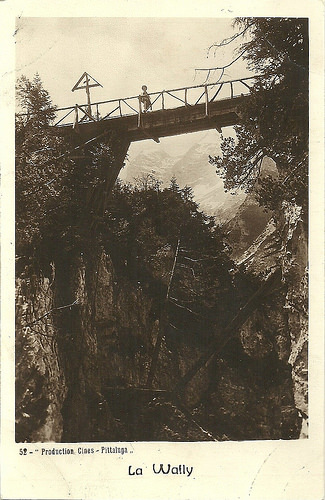
Italian postcard by G.B. Falci, Milano, no. 52. Photo: Cines-Pittaluga. Publicity still for La Wally (Guido Brignone, 1932), starring Germana Paolieri as Wally.
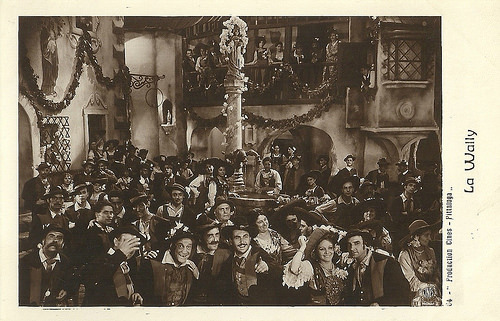
Italian postcard by G.B. Falci, Milano, no. 64. Photo: Cines-Pittaluga. Publicity still for La Wally (Guido Brignone, 1932).
A Story from the Tyrolean Alps
La Wally (1932) was directed by Guido Brignone and was based on the opera by composer Alfredo Catalani, to a libretto by Luigi Illica, first performed at La Scala, Milan in 1892. The libretto is based on a hugely successful Heimatroman by Wilhelmine von Hillern, Die Geier-Wally, Eine Geschichte aus den Tyroler Alpen (The Vulture Wally: A Story from the Tyrolean Alps).
While the Italian film version was in production in 1931, the press boosted that it would be released in six different versions: Italian, Spanish, English, German, French and ‘international’ (unspecified).
An orchestra of 150 musicians would accompany the visuals and a ballet of over 200 would do dance scenes, while location shooting was done in the village of Solden, involving 150 workers, 50 set designers and 25 painters.
The painter Gastone Medin provided an 80 m high and 25 m large background scenery. Authentic folklorist costumes from local museums in Bolzano, Merano and elsewhere were used.
The opera La Wally is now best known for its aria Ebben? Ne andrò lontana (Well, then? I'll go far away), sung when Wally decides to leave her home forever). American soprano Wilhelmenia Fernandez sang this aria in Jean-Jacques Beineix's thriller Diva (1981).

Italian postcard by G.B. Falci, Milano, no. 65. Photo: Cines-Pittaluga. Publicity still for La Wally (Guido Brignone, 1932).
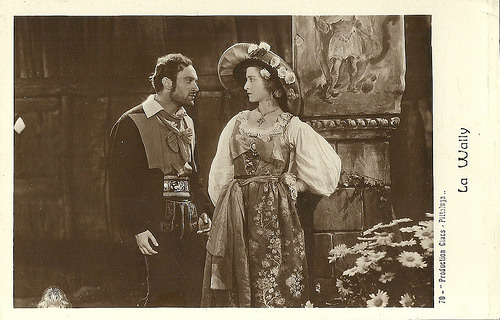
Italian postcard by G.B. Falci, Milano, no. 70. Photo: Cines-Pittaluga. Publicity still for La Wally (Guido Brignone, 1932), starring Germana Paolieri as Wally and Renzo Ricci as her jealous lover.

Italian postcard by G.B. Falci, Milano, no. 98. Photo: Cines-Pittaluga. Publicity still for La Wally (Guido Brignone, 1932), starring Germana Paolieri as Wally.
Trailer Diva (1981). Source: Umbrella Entertainment (YouTube).
Sources: Delpher (Dutch), Wikipedia (Italian and English) and IMDb.

Italian postcard by G.B. Falci, Milano, no. 60. Photo: Cines-Pittaluga. Publicity still for La Wally (Guido Brignone, 1932), starring Germana Paolieri as Wally.

Italian postcard by G.B. Falci, Milano, no. 3. Photo: Cines-Pittaluga. Publicity still for La Wally (Guido Brignone, 1932), co-starring Carlo Ninchi and Isa Pola .
A love obstructed
Wally ( Germana Paolieri ) loves bear hunter Hagenbach ( Carlo Ninchi ), but their love is obstructed by all close to them.
A rival lover, Vincenzo Gellner (Renzo Ricci) plots to set up Wally’s father Stromminger (Achille Majeroni) against Hagenbach, and an old feud between the old man and the young one restarts. In the village inn the two get into a fight, after which Wally’s is chased from her house and flees into the mountains.
A year passes, Stromminger dies and Wally inherits his fortune, while Hagenbach engages to Afra ( Isa Pola ). At the next Spring party in Sölden, both Hagenbach and Wally attend. Hagenbach’s friends bet he cannot kiss his former girlfriend but Hagenbach wins.
Yet, when Wally finds out she has been the object of a bet, she hates Hagenbach. She even pushes rival Gellner to kill Hagenbach, but she repents and saves him, lifting him unconscious from a ravine.
Wally hides in a cabin where her lover Hagenbach comes to ask for forgiveness. She also confesses and the two reunite. The film ends tragically though. Hagenbach dies because of an avalanche and out of despair Wally throws herself into the ravine.

Italian postcard with French text by G.B. Falci, Milano, no. 47. Photo: Cines-Pittaluga. Publicity still for La Wally (Guido Brignone, 1932), co-starring Carlo Ninchi .

Italian postcard by G.B. Falci, Milano, no. 52. Photo: Cines-Pittaluga. Publicity still for La Wally (Guido Brignone, 1932), starring Germana Paolieri as Wally.

Italian postcard by G.B. Falci, Milano, no. 64. Photo: Cines-Pittaluga. Publicity still for La Wally (Guido Brignone, 1932).
A Story from the Tyrolean Alps
La Wally (1932) was directed by Guido Brignone and was based on the opera by composer Alfredo Catalani, to a libretto by Luigi Illica, first performed at La Scala, Milan in 1892. The libretto is based on a hugely successful Heimatroman by Wilhelmine von Hillern, Die Geier-Wally, Eine Geschichte aus den Tyroler Alpen (The Vulture Wally: A Story from the Tyrolean Alps).
While the Italian film version was in production in 1931, the press boosted that it would be released in six different versions: Italian, Spanish, English, German, French and ‘international’ (unspecified).
An orchestra of 150 musicians would accompany the visuals and a ballet of over 200 would do dance scenes, while location shooting was done in the village of Solden, involving 150 workers, 50 set designers and 25 painters.
The painter Gastone Medin provided an 80 m high and 25 m large background scenery. Authentic folklorist costumes from local museums in Bolzano, Merano and elsewhere were used.
The opera La Wally is now best known for its aria Ebben? Ne andrò lontana (Well, then? I'll go far away), sung when Wally decides to leave her home forever). American soprano Wilhelmenia Fernandez sang this aria in Jean-Jacques Beineix's thriller Diva (1981).

Italian postcard by G.B. Falci, Milano, no. 65. Photo: Cines-Pittaluga. Publicity still for La Wally (Guido Brignone, 1932).

Italian postcard by G.B. Falci, Milano, no. 70. Photo: Cines-Pittaluga. Publicity still for La Wally (Guido Brignone, 1932), starring Germana Paolieri as Wally and Renzo Ricci as her jealous lover.

Italian postcard by G.B. Falci, Milano, no. 98. Photo: Cines-Pittaluga. Publicity still for La Wally (Guido Brignone, 1932), starring Germana Paolieri as Wally.
Trailer Diva (1981). Source: Umbrella Entertainment (YouTube).
Sources: Delpher (Dutch), Wikipedia (Italian and English) and IMDb.
Published on October 18, 2016 22:00
October 17, 2016
Pierre Etaix (1928-2016)
French clown, actor and filmmaker Pierre Etaix has died aged 87. Etaix, who, was directly inspired by Max Linder and Buster Keaton, kept the tradition of slapstick alive. In the 1960s he made a series of acclaimed short- and feature-length films, many of them co-written by Jean-Claude Carrière. He won an Academy Award for his short film Heureux Anniversaire/Happy Anniversary (1962). Due to a legal dispute with a distribution company, these films were unavailable for three decades. As an actor, assistant director and gag writer, Étaix worked with Jacques Tati, Robert Bresson, Nagisa Oshima, Otar Iosseliani and Jerry Lewis.
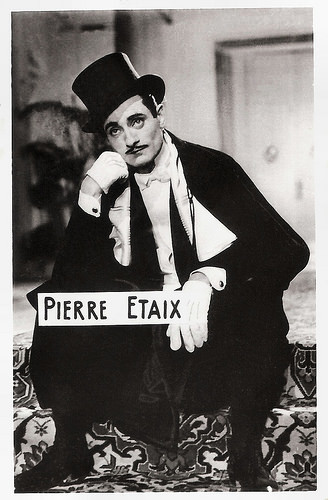
Romanian collectors card. Photo: publicity still for Yoyo/Yo Yo (Pierre Etaix, 1965).
Clucking to a woman who is de-feathering a chicken
Pierre Etaix was born in 1928 in Roanne on the river Loire in central France. He decided very young to become a clown. Knowing how many skills were needed to fulfill his ambition, he studied the violin and piano, dancing and gymnastics, while teaching himself to play the xylophone, accordion, saxophone, mandolin, trumpet and concertina, as well as learning to become a magician.
He was also trained as a designer, and was introduced to the art of stained glass by Theodore Gerard Hanssen. After joining an amateur theatre group in Roanne, Etaix moved to Paris in 1953, working as an illustrator, cartoonist and cabaret performer.
In 1954, he met Jacques Tati and managed to get taken on by his hero’s company, Spectra Films, which had started the lengthy preproduction of Mon Oncle/My Uncle (Jacques Tati, 1958). During the almost four years it took to make the film, Etaix acted as gag writer, assistant director, storyboardist, gofer and uncredited player. He is seen briefly wheeling a bicycle and, with an imitation of clucking, startling a woman who is de-feathering a chicken. He also created the wonderful poster for the film.
Later, Etaix performed comedy routines at the Parisian music hall Bobino, and at the cabaret Les Trois Baudets in Pigalle. He also appeared in Robert Bresson’s classic Pickpocket (1959), as one of the accomplices of the title character, and in the army comedy Tire-au-flanc/The Army Game (Claude de Givray, François Truffaut, 1961).
Excerpt from Tant Qu’on a la Santé/As Long As You’re Healthy (1966). Source: Janusfilms (YouTube).
A Love for the comedy kings of Hollywood in the 1920s
In 1960, Pierre Etaix met the then-unknown writer Jean-Claude Carrière, and they became friends. They shared a love for the comedy kings of Hollywood in the 1920s. They first collaborated on ‘novelisations’ of Les Vacances de Monsieur Hulot and Mon Oncle, written by Carrière and illustrated by Etaix.
Then they co-scripted and co-directed two shorts: Insomnie/Rupture (Pierre Etaix, 1961) and Heureux Anniversaire/Happy Anniversary (Pierre Etaix, 1962). The latter, which won the Oscar for best short film, had Etaix as a happily married man meeting a series of obstacles – mainly to do with traffic - as he desperately tries to get home in time for a celebratory dinner with his wife. Etaix, while paying homage to silent film comedy, paradoxically used sound effects as an important element in his work.
His first feature, Le Soupirant/The Suitor (Pierre Etaix, 1963), was a huge success at home and abroad, and established Etaix as ‘the French Buster Keaton ’. Some of the plot – a shy and studious young man has to get married in a hurry – echoes that of Seven Chances (Buster Keaton, 1925), and a scene where Etaix attempts to carry a drunk young woman up to her apartment is almost a carbon copy of a similar one in Keaton’s Spite Marriage (Edward Sedgwick, 1929).
His next film, Yoyo/Yo Yo (Pierre Etaix, 1965), was his masterpiece. He plays a spoilt millionaire who loses everything in the Wall Street crash, then finds his former sweetheart, a circus horse rider, and their son Yoyo, a budding clown. Ronald Bergan in his excellent obituary of Etaix in The Guardian : “This enchanting nostalgic comedy romance, paying tribute to the tone and technique of silent cinema, has no dialogue for the first 30 minutes except for creative sound effects such as the creaking of the vast chateau doors. As both the adult Yoyo and the millionaire, Etaix brought the same control and sense of style to his performance as to his direction.”
He then directed two feature films Tant Qu’on a la Santé/As Long As You’re Healthy (Pierre Etaix, 1966) and Le Grand Amour/The Great Love (Pierre Etaix, 1969), which he co-authored with Jean-Claude Carrière. Tant Qu’on a la Santé looked at the absurdity of modern life. In a series of comic set pieces, Etaix played a serious-minded young man harassed wherever he goes – in the city crowds and traffic, at the doctor’s surgery, on a camping site and even on a desert island. Le Grand Amour was Etaix’s first film in colour, about a middle-aged married man who falls for a much younger woman. The wife was played by Annie Fratellini, one of the few female circus clowns in France, whom Etaix married in 1969.
Dream scene from Le Grand Amour/The Great Love (1969). Source: JLoveBirch (YouTube).
Federico Fellini
Both Pierre Etaix and Annie Fratellini were featured in Federico Fellini’s semi-documentary I clowns/The Clowns (1970) about the human fascination with clowns and circuses. In 1974, Fratellini and her husband founded France's first circus school.
Etaix’s last feature was the documentary Pays de Cocagne/Land of Milk and Honey (Pierre Etaix, 1971). Ronald Bergan: “a penetrating, rather cruel and satirical look at the French on holiday and their reactions to topical questions put to them by a hidden inquisitor (Etaix). The film, which was edited down from six hours of material to 80 minutes, was both a commercial and a critical failure, and Etaix was seldom seen on the big or small screen thereafter. In fact, he ‘vanished’ for some years when he and Fratellini joined the touring Pinder Circus as clowns.”
In 1972, Jerry Lewis cast the comedian in his unreleased film drama The Day the Clown Cried. Later, Etaix wrote a play, L’Age de Monsieur est Avancé (The Gentleman is Getting On), which was successfully staged in the autumn of 1985 at the Comédie des Champs-Elysées theatre in Paris. Etaix filmed it for television two years later in which he played the lead role opposite Nicole Calfan and Jean Carmet.
Among his later film appearances were roles as a detective in Nagisa Oshima’s Max Mon Amour (1986) and as a friend of Henry Miller (Fred Ward) in Henry and June (Philip Kaufman, 1990). He also appeared in Jardins en Automne/Gardens in Autumn (2006), Chantrapas (2010) and Winter Song (2015), all directed by the Tati and Etaix admirer Otar Iosseliani, the exiled Georgian in Paris. Etaix also played a role in Aki Kaurismäki’s Le Havre (2011).
Because of complex contractual problems, his old films could not been shown for three decades – either in cinemas, on television or on DVD. At last, in 2010, after more than 50,000 people – including Woody Allen, David Lynch, Charlotte Rampling and Jean-Luc Godard – had signed a petition, the films could be restored and rereleased. They were a revelation to a younger generation. In the same year, he toured France with a show inspired by music hall, Miousik Papillon.
In January 2013, the French government promoted Etaix to the rank of Commandeur des Arts et des Lettres. In June 2013 he received the Grand Prize of the SACD (Society of Authors and Composers of Dramatic) for his entire career. Annie Fratellini has died of cancer in 1997. Pierre Etaix is survived by their son, Marc, and by his second wife, Odile (nee Crépin), a former jazz singer. Le Monde reports that the cause of his death was an intestinal infection.
James Travers at Films de France : “The precise, gentle comedy of Pierre Etaix invites not just admiration, but also genuine affection. Sweet but never mawkish, acerbic but never cruel, his films are packed with as much humanity as humour, and will move you as much as they will make you laugh.”
American trailer for the 2012-2013 retrospective of the films of Pierre Étaix. Source: Janusfilms (YouTube).
Sources: Ronald Bergan (The Guardian), James Travers (Films de France), Ignatiy Vishnevetsky (A.V. Club), Le Monde (French), Wikipedia (French and English), and .

Romanian collectors card. Photo: publicity still for Yoyo/Yo Yo (Pierre Etaix, 1965).
Clucking to a woman who is de-feathering a chicken
Pierre Etaix was born in 1928 in Roanne on the river Loire in central France. He decided very young to become a clown. Knowing how many skills were needed to fulfill his ambition, he studied the violin and piano, dancing and gymnastics, while teaching himself to play the xylophone, accordion, saxophone, mandolin, trumpet and concertina, as well as learning to become a magician.
He was also trained as a designer, and was introduced to the art of stained glass by Theodore Gerard Hanssen. After joining an amateur theatre group in Roanne, Etaix moved to Paris in 1953, working as an illustrator, cartoonist and cabaret performer.
In 1954, he met Jacques Tati and managed to get taken on by his hero’s company, Spectra Films, which had started the lengthy preproduction of Mon Oncle/My Uncle (Jacques Tati, 1958). During the almost four years it took to make the film, Etaix acted as gag writer, assistant director, storyboardist, gofer and uncredited player. He is seen briefly wheeling a bicycle and, with an imitation of clucking, startling a woman who is de-feathering a chicken. He also created the wonderful poster for the film.
Later, Etaix performed comedy routines at the Parisian music hall Bobino, and at the cabaret Les Trois Baudets in Pigalle. He also appeared in Robert Bresson’s classic Pickpocket (1959), as one of the accomplices of the title character, and in the army comedy Tire-au-flanc/The Army Game (Claude de Givray, François Truffaut, 1961).
Excerpt from Tant Qu’on a la Santé/As Long As You’re Healthy (1966). Source: Janusfilms (YouTube).
A Love for the comedy kings of Hollywood in the 1920s
In 1960, Pierre Etaix met the then-unknown writer Jean-Claude Carrière, and they became friends. They shared a love for the comedy kings of Hollywood in the 1920s. They first collaborated on ‘novelisations’ of Les Vacances de Monsieur Hulot and Mon Oncle, written by Carrière and illustrated by Etaix.
Then they co-scripted and co-directed two shorts: Insomnie/Rupture (Pierre Etaix, 1961) and Heureux Anniversaire/Happy Anniversary (Pierre Etaix, 1962). The latter, which won the Oscar for best short film, had Etaix as a happily married man meeting a series of obstacles – mainly to do with traffic - as he desperately tries to get home in time for a celebratory dinner with his wife. Etaix, while paying homage to silent film comedy, paradoxically used sound effects as an important element in his work.
His first feature, Le Soupirant/The Suitor (Pierre Etaix, 1963), was a huge success at home and abroad, and established Etaix as ‘the French Buster Keaton ’. Some of the plot – a shy and studious young man has to get married in a hurry – echoes that of Seven Chances (Buster Keaton, 1925), and a scene where Etaix attempts to carry a drunk young woman up to her apartment is almost a carbon copy of a similar one in Keaton’s Spite Marriage (Edward Sedgwick, 1929).
His next film, Yoyo/Yo Yo (Pierre Etaix, 1965), was his masterpiece. He plays a spoilt millionaire who loses everything in the Wall Street crash, then finds his former sweetheart, a circus horse rider, and their son Yoyo, a budding clown. Ronald Bergan in his excellent obituary of Etaix in The Guardian : “This enchanting nostalgic comedy romance, paying tribute to the tone and technique of silent cinema, has no dialogue for the first 30 minutes except for creative sound effects such as the creaking of the vast chateau doors. As both the adult Yoyo and the millionaire, Etaix brought the same control and sense of style to his performance as to his direction.”
He then directed two feature films Tant Qu’on a la Santé/As Long As You’re Healthy (Pierre Etaix, 1966) and Le Grand Amour/The Great Love (Pierre Etaix, 1969), which he co-authored with Jean-Claude Carrière. Tant Qu’on a la Santé looked at the absurdity of modern life. In a series of comic set pieces, Etaix played a serious-minded young man harassed wherever he goes – in the city crowds and traffic, at the doctor’s surgery, on a camping site and even on a desert island. Le Grand Amour was Etaix’s first film in colour, about a middle-aged married man who falls for a much younger woman. The wife was played by Annie Fratellini, one of the few female circus clowns in France, whom Etaix married in 1969.
Dream scene from Le Grand Amour/The Great Love (1969). Source: JLoveBirch (YouTube).
Federico Fellini
Both Pierre Etaix and Annie Fratellini were featured in Federico Fellini’s semi-documentary I clowns/The Clowns (1970) about the human fascination with clowns and circuses. In 1974, Fratellini and her husband founded France's first circus school.
Etaix’s last feature was the documentary Pays de Cocagne/Land of Milk and Honey (Pierre Etaix, 1971). Ronald Bergan: “a penetrating, rather cruel and satirical look at the French on holiday and their reactions to topical questions put to them by a hidden inquisitor (Etaix). The film, which was edited down from six hours of material to 80 minutes, was both a commercial and a critical failure, and Etaix was seldom seen on the big or small screen thereafter. In fact, he ‘vanished’ for some years when he and Fratellini joined the touring Pinder Circus as clowns.”
In 1972, Jerry Lewis cast the comedian in his unreleased film drama The Day the Clown Cried. Later, Etaix wrote a play, L’Age de Monsieur est Avancé (The Gentleman is Getting On), which was successfully staged in the autumn of 1985 at the Comédie des Champs-Elysées theatre in Paris. Etaix filmed it for television two years later in which he played the lead role opposite Nicole Calfan and Jean Carmet.
Among his later film appearances were roles as a detective in Nagisa Oshima’s Max Mon Amour (1986) and as a friend of Henry Miller (Fred Ward) in Henry and June (Philip Kaufman, 1990). He also appeared in Jardins en Automne/Gardens in Autumn (2006), Chantrapas (2010) and Winter Song (2015), all directed by the Tati and Etaix admirer Otar Iosseliani, the exiled Georgian in Paris. Etaix also played a role in Aki Kaurismäki’s Le Havre (2011).
Because of complex contractual problems, his old films could not been shown for three decades – either in cinemas, on television or on DVD. At last, in 2010, after more than 50,000 people – including Woody Allen, David Lynch, Charlotte Rampling and Jean-Luc Godard – had signed a petition, the films could be restored and rereleased. They were a revelation to a younger generation. In the same year, he toured France with a show inspired by music hall, Miousik Papillon.
In January 2013, the French government promoted Etaix to the rank of Commandeur des Arts et des Lettres. In June 2013 he received the Grand Prize of the SACD (Society of Authors and Composers of Dramatic) for his entire career. Annie Fratellini has died of cancer in 1997. Pierre Etaix is survived by their son, Marc, and by his second wife, Odile (nee Crépin), a former jazz singer. Le Monde reports that the cause of his death was an intestinal infection.
James Travers at Films de France : “The precise, gentle comedy of Pierre Etaix invites not just admiration, but also genuine affection. Sweet but never mawkish, acerbic but never cruel, his films are packed with as much humanity as humour, and will move you as much as they will make you laugh.”
American trailer for the 2012-2013 retrospective of the films of Pierre Étaix. Source: Janusfilms (YouTube).
Sources: Ronald Bergan (The Guardian), James Travers (Films de France), Ignatiy Vishnevetsky (A.V. Club), Le Monde (French), Wikipedia (French and English), and .
Published on October 17, 2016 22:00
October 16, 2016
Emma Gramatica
Emma Gramatica (1874-1965) was a ‘monstre sacré’ of the Italian stage, but she also played many old ladies in Italian films of the 1930s to the 1950s. She was the sister of the equally famous Irma Gramatica.

Italian postcard, no. 664. Photo: Sciutto, Genoa.
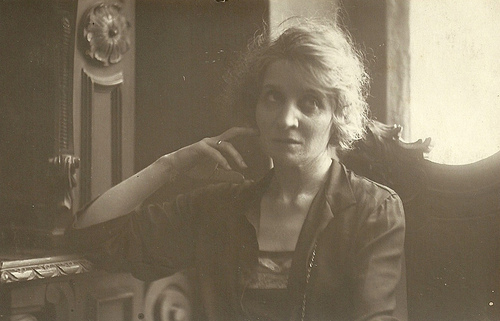
Italian postcard by Leonar, no. 2131. August 1922.
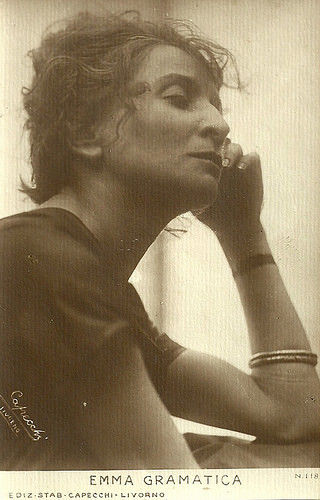
Italian postcard by Ed. Stab. Capecchi, Livorno, no. 118. Photo: Capecchi, Livorno.
An elegantly incisive interpretive charge
Emma Gramatica was born Aida Laura Argia Gramatica in Borgo San Donnino, Italy, in 1874. She was the sister of Irma Gramatica ; and of the lesser known Anna Adele Alberta Gramatica. Anna was married to Ruggero Capodaglio and sister-in-law of the famous actress Wanda Capodaglio.
She was still a teenager when she made her stage debut next to Eleonora Duse in La Gioconda by Gabriele D'Annunzio. Emma was equipped with a physical appearance that was far from flashy, but with an elegantly incisive interpretive charge, she made her debut in the theatre.
Emma became the 'primattrice' (first actress) at the stage companies of some of the most prestigious names in the Italian theatre of the late 19th and the early 20th century, such as Ermete Zacconi , Flavio Andò, Enrico Reinach and Ermete Novelli .
In the 1910s she formed the famous company Gramatica-Carini-Piperno, in which many great actors had their formation such as Renzo Ricci and Lola Braccini.
In 1916 Emma debuted on the silver screen as a marriage wrecker in Quando il canto si spegne/When the hand goes out (Emilio Graziani-Walter, 1916), opposite Luigi Serventi . The film was produced by the Milanese company General Film. Although they praised her stage qualities, the press condemned her for her looks and theatricality, and didn’t accept her as the mistress for which a man breaks up his marriage. Gramatica understood the message and would stay away from the screen until the arrival of sound cinema in Italy.

German postcard by NPG (Neue Photographische Gesellschaft), no. 6. Card dated 11 September 1903. Back is Italian: ASC Diffida.
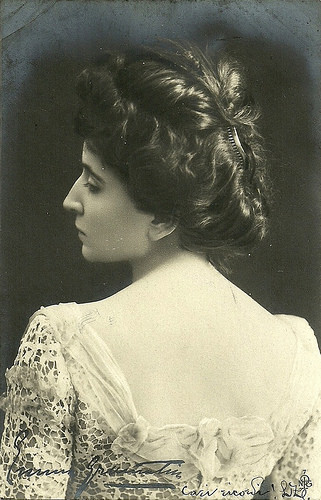
Italian/German postcard by NPG, no. 7. Back: ASC Diffida.
Acute and pathetic tones
From the early 1930s, Emma Gramatica did prose on radio, first with EIAR and later also with RAI. Gramatica was an actress of the old naturalist school, of acute and pathetic tones.
At a high age she started a successful film and television career, staring with La vecchia signora/The Old Lady (Amleto Palermi, 1931) as an impoverished lady who sells chestnuts on the streets to support her niece.
Gramatica was memorable in Napoli d’altri tempi/Naples of Former Days (Amleto Palermi, 1938) starring Vittorio De Sica , in Mamma (Guido Brignone, 1941) as the mother of Beniamino Gigli, in the melodrama Sissignora/Yes, Madam (Ferdinando Maria Poggioli, 1941) and in the comedy Sorelle Materassi/The Materassi Sisters (Ferdinando Maria Poggioli, 1944), in which she and her sister Irma played two old spinsters.
In her most famous film, Miracolo in Milano/Miracle in Milan (Vittorio De Sica, 1951), she played old Lolotta who finds young Totò (Francesco Golisano) among the cauliflowers in her garden and raises him with an optimist and kind outlook.
She also appeared in Don Camillo Monsignore ... ma non troppo/Don Camillo: Monsignor (Carmine Gallone, 1961) starring Fernandel and Gino Cervi .
Emma Gramatica received awards and honors in Italy and also the Legion of Honor in France. She died in 1965 in Ostia, near Rome, and rests in the family tomb in the cemetery of Signa, with her sister Irma and their parents.

Italian postcard by Ed. A. Vettori, Bologna. Photo: Badodi, Milano. Prob. 1920s.

Italian postcard, no. 655. Photo: Sciutto, Genoa.

Italian postcard for Sissignora/Yes Madam (Ferdinando Maria Poggioli, 1941), with Maria Denis , Irma and Emma Grammatica and Leonardo Cortese .
Sources: Wikipedia (Italian and English) and .

Italian postcard, no. 664. Photo: Sciutto, Genoa.

Italian postcard by Leonar, no. 2131. August 1922.

Italian postcard by Ed. Stab. Capecchi, Livorno, no. 118. Photo: Capecchi, Livorno.
An elegantly incisive interpretive charge
Emma Gramatica was born Aida Laura Argia Gramatica in Borgo San Donnino, Italy, in 1874. She was the sister of Irma Gramatica ; and of the lesser known Anna Adele Alberta Gramatica. Anna was married to Ruggero Capodaglio and sister-in-law of the famous actress Wanda Capodaglio.
She was still a teenager when she made her stage debut next to Eleonora Duse in La Gioconda by Gabriele D'Annunzio. Emma was equipped with a physical appearance that was far from flashy, but with an elegantly incisive interpretive charge, she made her debut in the theatre.
Emma became the 'primattrice' (first actress) at the stage companies of some of the most prestigious names in the Italian theatre of the late 19th and the early 20th century, such as Ermete Zacconi , Flavio Andò, Enrico Reinach and Ermete Novelli .
In the 1910s she formed the famous company Gramatica-Carini-Piperno, in which many great actors had their formation such as Renzo Ricci and Lola Braccini.
In 1916 Emma debuted on the silver screen as a marriage wrecker in Quando il canto si spegne/When the hand goes out (Emilio Graziani-Walter, 1916), opposite Luigi Serventi . The film was produced by the Milanese company General Film. Although they praised her stage qualities, the press condemned her for her looks and theatricality, and didn’t accept her as the mistress for which a man breaks up his marriage. Gramatica understood the message and would stay away from the screen until the arrival of sound cinema in Italy.

German postcard by NPG (Neue Photographische Gesellschaft), no. 6. Card dated 11 September 1903. Back is Italian: ASC Diffida.

Italian/German postcard by NPG, no. 7. Back: ASC Diffida.
Acute and pathetic tones
From the early 1930s, Emma Gramatica did prose on radio, first with EIAR and later also with RAI. Gramatica was an actress of the old naturalist school, of acute and pathetic tones.
At a high age she started a successful film and television career, staring with La vecchia signora/The Old Lady (Amleto Palermi, 1931) as an impoverished lady who sells chestnuts on the streets to support her niece.
Gramatica was memorable in Napoli d’altri tempi/Naples of Former Days (Amleto Palermi, 1938) starring Vittorio De Sica , in Mamma (Guido Brignone, 1941) as the mother of Beniamino Gigli, in the melodrama Sissignora/Yes, Madam (Ferdinando Maria Poggioli, 1941) and in the comedy Sorelle Materassi/The Materassi Sisters (Ferdinando Maria Poggioli, 1944), in which she and her sister Irma played two old spinsters.
In her most famous film, Miracolo in Milano/Miracle in Milan (Vittorio De Sica, 1951), she played old Lolotta who finds young Totò (Francesco Golisano) among the cauliflowers in her garden and raises him with an optimist and kind outlook.
She also appeared in Don Camillo Monsignore ... ma non troppo/Don Camillo: Monsignor (Carmine Gallone, 1961) starring Fernandel and Gino Cervi .
Emma Gramatica received awards and honors in Italy and also the Legion of Honor in France. She died in 1965 in Ostia, near Rome, and rests in the family tomb in the cemetery of Signa, with her sister Irma and their parents.

Italian postcard by Ed. A. Vettori, Bologna. Photo: Badodi, Milano. Prob. 1920s.

Italian postcard, no. 655. Photo: Sciutto, Genoa.

Italian postcard for Sissignora/Yes Madam (Ferdinando Maria Poggioli, 1941), with Maria Denis , Irma and Emma Grammatica and Leonardo Cortese .
Sources: Wikipedia (Italian and English) and .
Published on October 16, 2016 22:00
October 15, 2016
Pietje Bell (2002)
Every autumn, the Cinekid Film, Television and New Media Festival offers films, workshops and masterclasses for Dutch children during the school holidays. This year, the international festival celebrates its 30th anniversary, and yesterday started the ten days’ event in Amsterdam and 30 other cities in the Netherlands EFSP salutes this wonderful festival with a post on the Dutch family film Pietje Bell/Peter Bell (Maria Peters, 2002). Based on the popular Pietje Bell books of Chris van Abkoude, the film tells the tales of a young rascal with a heart of gold, who always gets into trouble. Pietje was played by the director’s son, the then 10-years old Quinten Schram, and the film became a box-office hit in the Netherlands.
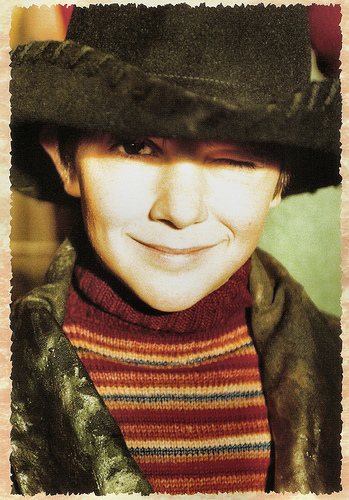
Dutch postcard by Rubinstein. Photo: publicity still for Pietje Bell/Peter Bell (Maria Peters, 2002) featuring Quinten Schram. Caption: Pietje Bell.
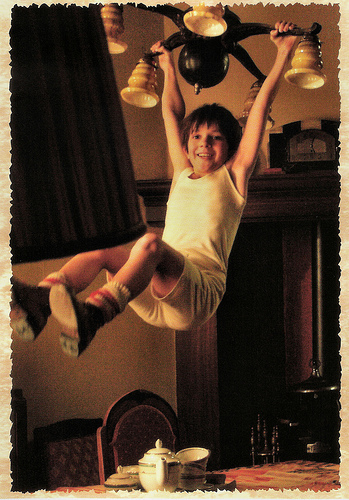
Dutch postcard by Rubinstein. Photo: publicity still for Pietje Bell/Peter Bell (Maria Peters, 2002) featuring Quinten Schram. Caption: Pietje Bell.
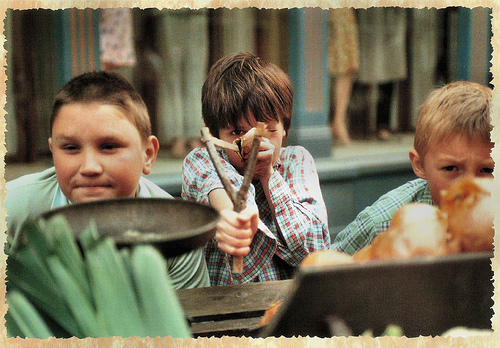
Dutch postcard by Rubinstein. Photo: publicity still for Pietje Bell/Peter Bell (Maria Peters, 2002) featuring Quinten Schram as Pietje, Jordy Mul as Ebgeltje and Sjoerd Metz as Peentje. Caption: the gang set off.
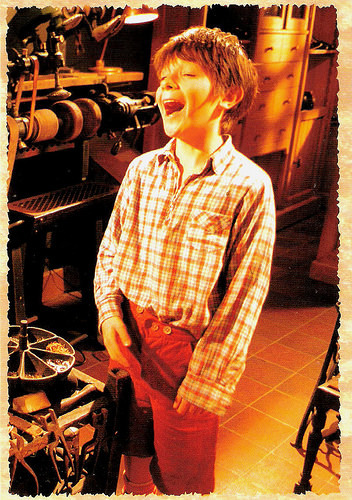
Dutch postcard by Rubinstein. Photo: publicity still for Pietje Bell/Peter Bell (Maria Peters, 2002) featuring Quinten Schram. Caption: Pietje Bell.

Dutch postcard by Rubinstein. Photo: publicity still for Pietje Bell/Peter Bell (Maria Peters, 2002) featuring Quinten Schram. Caption: Pietje Bell.
A scamp with a heart of gold
The Pietje Bell children's books were written by the Dutch writer Chris van Abkoude. He wrote the first book of the series in 1914.
Pietje Bell is situated in the city of Rotterdam during the early 20th Century. Pietje (Little Peter) is the son of cheerful shoemaker Bell (Felix Strategier) and is a scamp with a heart of gold.
The boy and his 'Robin Hood'-type gang of the Black Hand repeatedly end up in trouble. Pietje does not want to be naughty but tries to make people laugh. This always goes wrong.
Piet's sister Martha (Katja Herbers) is engaged and later married to Paul Velinga (Rick Engelkes), son of a distinguished family. He's about the only one who understands the boy.
Pietje’s big enemies are the chemist Geelman (Arjan Ederveen) and his son Joseph (Stijn Westenend). When the chemist complains to father Bell about Pietje’s brutality (he has called Geelman ‘bald head’, for example), Pietje’s father can only laugh about it.
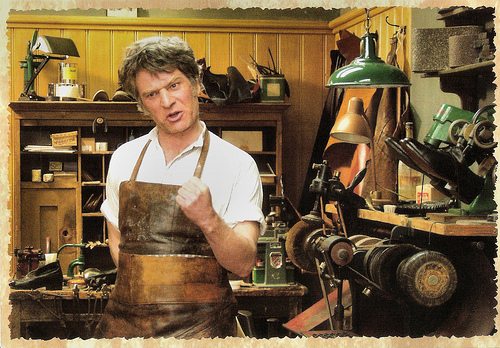
Dutch postcard by Rubinstein. Photo: publicity still for Pietje Bell/Peter Bell (Maria Peters, 2002) featuring Felix Strategier as Vader Bell. Caption: Father Bell.
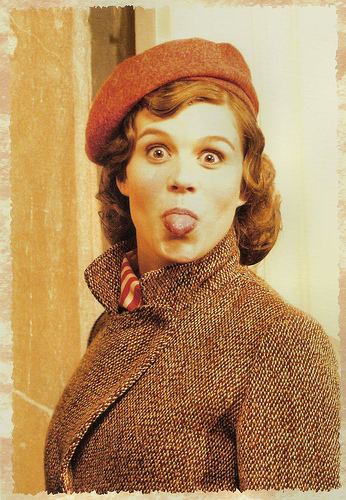
Dutch postcard by Rubinstein. Photo: publicity still for Pietje Bell/Peter Bell (Maria Peters, 2002) with Katja Herbers as Martha Bell. Caprion: Martha Bell.
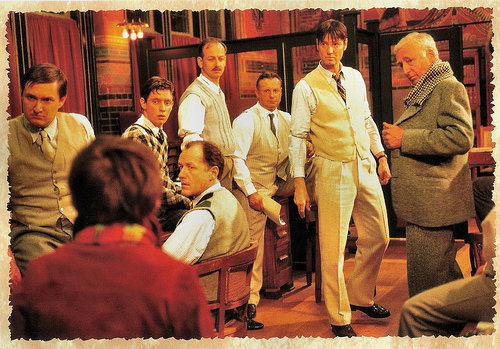
Dutch postcard by Rubinstein. Photo: publicity still for Pietje Bell/Peter Bell (Maria Peters, 2002) featuring Quinten Schram as Pietje Bell, Rick Engelkes as Paul Velinga, and Herman Vinck as the editor. Caption: Pietje Bell visiting the newspaper Het Laatste Nieuws (The Latest News).
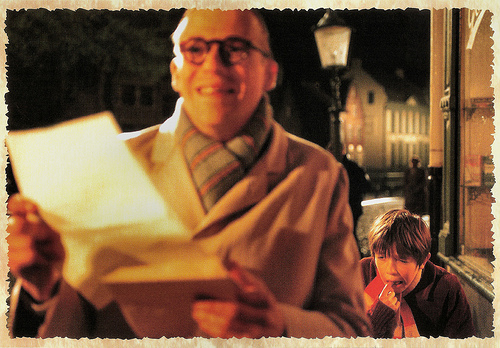
Dutch postcard by Rubinstein. Photo: publicity still for Pietje Bell/Peter Bell (Maria Peters, 2002) featuring Quinten Schram as Pietje Bell and Stijn Westenend as Jozef Geelhoed. Caption: Jozef Geelhoed.
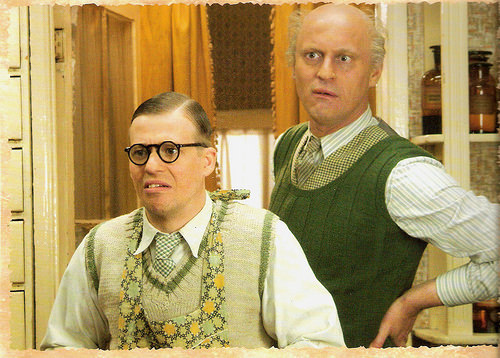
Dutch postcard by Rubinstein. Photo: publicity still for Pietje Bell/Peter Bell (Maria Peters, 2002) featuring Stijn Westenend and Arjan Ederveen as son and father Geelhoed.
Box Office Hit
Chris van Abkoude’s stories about Pietje have been adapted to film twice. The first adaptation was De Avonturen van Pietje Bell/The Aventures of Pietje Bell, directed by Henk van der Linden in 1964.
This second adaptation is made by Maria Peters, who is responsible for both the script and the direction. She was previously responsible for the filming of Kruimeltje/Little Crumb (1998), another classic children’s book by Chris van Abkoude. Both films were produced by Hans Pos and Dave Schram, Maria’s husband. The lead role of Pietje was played by their son Quinten Schram (1992).
Branko Collin at IMDb : “nice images, good adventure, so-so acting of the leads and sometimes irksome dialogue. The Rotterdam of the 1920s was convincingly portrayed. There was a cartoonesque feel to the decor, which made it easier to focus on the story.”
The film was a box office hit. Pietje Bell received a Golden Film (75,000 visitors) as well as a Platinum Film (200,000 visitors) in 2002.
The next year, a sequel followed, made by the same team: Pietje Bell II: De jacht op de tsarenkroon/Peter Bell II: The Hunt for the Czar Crown (Maria Peters, 2003). That same year, composer Ruud Bos adapted the novel into a musical called Pietje Bell - De Musical.

Dutch postcard by Rubinstein. Photo: publicity still for Pietje Bell/Peter Bell (Maria Peters, 2002) featuring Quinten Schram. Caption: The Black Hand Gang.
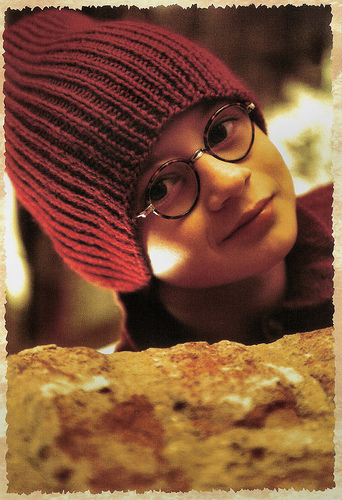
Dutch postcard by Rubinstein. Photo: publicity still for Pietje Bell/Peter Bell (Maria Peters, 2002) with Serge Price as Kees. Caption: Kees.
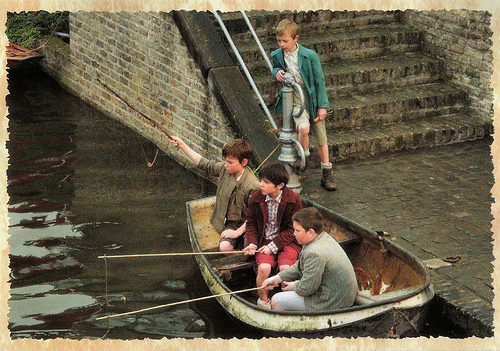
Dutch postcard by Rubinstein. Photo: publicity still for Pietje Bell/Peter Bell (Maria Peters, 2002) featuring Quinten Schram as Pietje Bell, Frensch de Groot as Sproet, Sjoerd Metz as Peentje, and Jordy Mul as Engeltje. Caption: The Black Hand gang goes fishing.
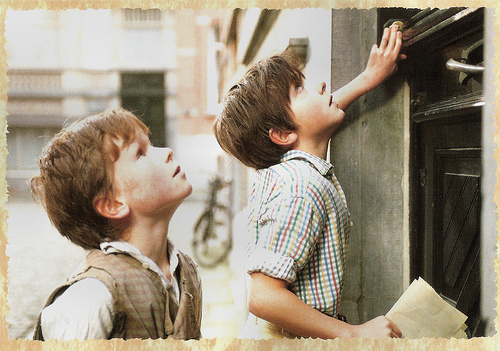
Dutch postcard by Rubinstein. Photo: publicity still for Pietje Bell/Peter Bell (Maria Peters, 2002) featuring Quinten Schram and Frensch de Groot. Caption: Pietje and Sproet.

Big Dutch postcard by Rubinstein. Photo: publicity still for Pietje Bell/Peter Bell (Maria Peters, 2002). Caption: The secret clubhouse of the Black Hand gang.
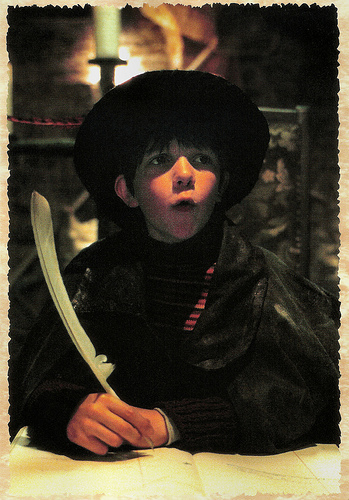
Dutch postcard by Rubinstein. Photo: publicity still for Pietje Bell/Peter Bell (Maria Peters, 2002) featuring Quinten Schram. Caption: the President of the Black Hand Gang - Pietje Bell.
Sources: Wikipedia (Dutch and English) and IMDb.

Dutch postcard by Rubinstein. Photo: publicity still for Pietje Bell/Peter Bell (Maria Peters, 2002) featuring Quinten Schram. Caption: Pietje Bell.

Dutch postcard by Rubinstein. Photo: publicity still for Pietje Bell/Peter Bell (Maria Peters, 2002) featuring Quinten Schram. Caption: Pietje Bell.

Dutch postcard by Rubinstein. Photo: publicity still for Pietje Bell/Peter Bell (Maria Peters, 2002) featuring Quinten Schram as Pietje, Jordy Mul as Ebgeltje and Sjoerd Metz as Peentje. Caption: the gang set off.

Dutch postcard by Rubinstein. Photo: publicity still for Pietje Bell/Peter Bell (Maria Peters, 2002) featuring Quinten Schram. Caption: Pietje Bell.

Dutch postcard by Rubinstein. Photo: publicity still for Pietje Bell/Peter Bell (Maria Peters, 2002) featuring Quinten Schram. Caption: Pietje Bell.
A scamp with a heart of gold
The Pietje Bell children's books were written by the Dutch writer Chris van Abkoude. He wrote the first book of the series in 1914.
Pietje Bell is situated in the city of Rotterdam during the early 20th Century. Pietje (Little Peter) is the son of cheerful shoemaker Bell (Felix Strategier) and is a scamp with a heart of gold.
The boy and his 'Robin Hood'-type gang of the Black Hand repeatedly end up in trouble. Pietje does not want to be naughty but tries to make people laugh. This always goes wrong.
Piet's sister Martha (Katja Herbers) is engaged and later married to Paul Velinga (Rick Engelkes), son of a distinguished family. He's about the only one who understands the boy.
Pietje’s big enemies are the chemist Geelman (Arjan Ederveen) and his son Joseph (Stijn Westenend). When the chemist complains to father Bell about Pietje’s brutality (he has called Geelman ‘bald head’, for example), Pietje’s father can only laugh about it.

Dutch postcard by Rubinstein. Photo: publicity still for Pietje Bell/Peter Bell (Maria Peters, 2002) featuring Felix Strategier as Vader Bell. Caption: Father Bell.

Dutch postcard by Rubinstein. Photo: publicity still for Pietje Bell/Peter Bell (Maria Peters, 2002) with Katja Herbers as Martha Bell. Caprion: Martha Bell.

Dutch postcard by Rubinstein. Photo: publicity still for Pietje Bell/Peter Bell (Maria Peters, 2002) featuring Quinten Schram as Pietje Bell, Rick Engelkes as Paul Velinga, and Herman Vinck as the editor. Caption: Pietje Bell visiting the newspaper Het Laatste Nieuws (The Latest News).

Dutch postcard by Rubinstein. Photo: publicity still for Pietje Bell/Peter Bell (Maria Peters, 2002) featuring Quinten Schram as Pietje Bell and Stijn Westenend as Jozef Geelhoed. Caption: Jozef Geelhoed.

Dutch postcard by Rubinstein. Photo: publicity still for Pietje Bell/Peter Bell (Maria Peters, 2002) featuring Stijn Westenend and Arjan Ederveen as son and father Geelhoed.
Box Office Hit
Chris van Abkoude’s stories about Pietje have been adapted to film twice. The first adaptation was De Avonturen van Pietje Bell/The Aventures of Pietje Bell, directed by Henk van der Linden in 1964.
This second adaptation is made by Maria Peters, who is responsible for both the script and the direction. She was previously responsible for the filming of Kruimeltje/Little Crumb (1998), another classic children’s book by Chris van Abkoude. Both films were produced by Hans Pos and Dave Schram, Maria’s husband. The lead role of Pietje was played by their son Quinten Schram (1992).
Branko Collin at IMDb : “nice images, good adventure, so-so acting of the leads and sometimes irksome dialogue. The Rotterdam of the 1920s was convincingly portrayed. There was a cartoonesque feel to the decor, which made it easier to focus on the story.”
The film was a box office hit. Pietje Bell received a Golden Film (75,000 visitors) as well as a Platinum Film (200,000 visitors) in 2002.
The next year, a sequel followed, made by the same team: Pietje Bell II: De jacht op de tsarenkroon/Peter Bell II: The Hunt for the Czar Crown (Maria Peters, 2003). That same year, composer Ruud Bos adapted the novel into a musical called Pietje Bell - De Musical.

Dutch postcard by Rubinstein. Photo: publicity still for Pietje Bell/Peter Bell (Maria Peters, 2002) featuring Quinten Schram. Caption: The Black Hand Gang.

Dutch postcard by Rubinstein. Photo: publicity still for Pietje Bell/Peter Bell (Maria Peters, 2002) with Serge Price as Kees. Caption: Kees.

Dutch postcard by Rubinstein. Photo: publicity still for Pietje Bell/Peter Bell (Maria Peters, 2002) featuring Quinten Schram as Pietje Bell, Frensch de Groot as Sproet, Sjoerd Metz as Peentje, and Jordy Mul as Engeltje. Caption: The Black Hand gang goes fishing.

Dutch postcard by Rubinstein. Photo: publicity still for Pietje Bell/Peter Bell (Maria Peters, 2002) featuring Quinten Schram and Frensch de Groot. Caption: Pietje and Sproet.

Big Dutch postcard by Rubinstein. Photo: publicity still for Pietje Bell/Peter Bell (Maria Peters, 2002). Caption: The secret clubhouse of the Black Hand gang.

Dutch postcard by Rubinstein. Photo: publicity still for Pietje Bell/Peter Bell (Maria Peters, 2002) featuring Quinten Schram. Caption: the President of the Black Hand Gang - Pietje Bell.
Sources: Wikipedia (Dutch and English) and IMDb.
Published on October 15, 2016 22:00
October 14, 2016
Imported from the USA: Marilyn Monroe
This year Marilyn Monroe (1926-1962) would have turned 90. Till 5 February 2017, De Nieuwe Kerk (The New Church) in Amsterdam, The Netherlands, presents the exhibition 90 Years Ms Monroe about her life and legacy, including numerous personal items from her house at 5th Helena Drive in Brentwood, California. Film institute EYE will present six classic MM films from 22 December on. Today, Marilyn Monroe is also the first Hollywood star in a new series of 'Imported from the USA' posts at EFSP. So, what did she do in Europe? In Great Britain she was directed by Sir Laurence Olivier in The Prince and the Showgirl (1957).
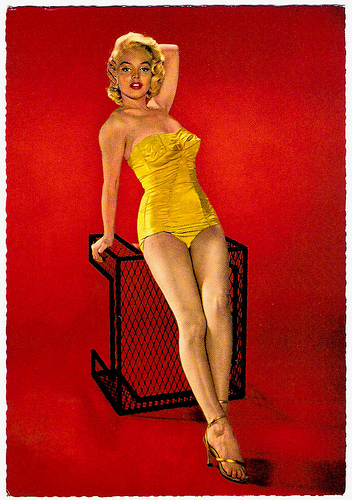
German postcard by ISV, Sort. VI/6.
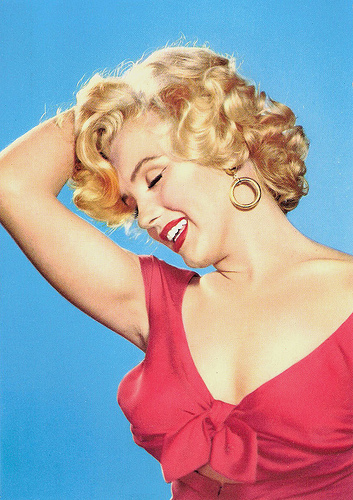
Italian postcard by Rotalcolor, Milano, no. 36. Photo: publicity still for Niagara (Henry Hathaway, 1953).
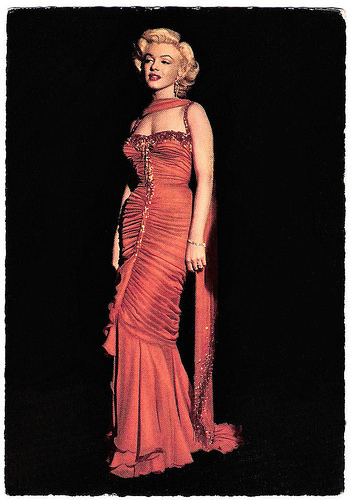
West-German postcard by Krüger, no. 902/13. Photo: publicity still for Gentlemen Prefer Blondes (Howard Hawks, 1953).
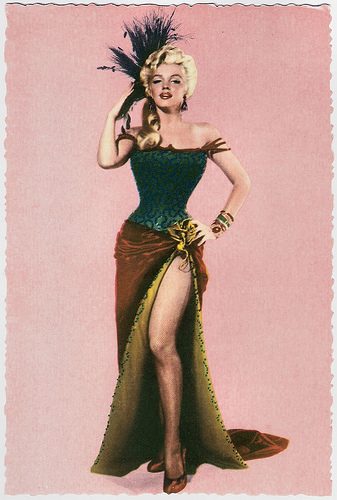
Spanish postcard by Archivo Bermejo, no. 7. Photo: 20th Century Fox. Publicity still for River of No Return (Otto Preminger, 1954).
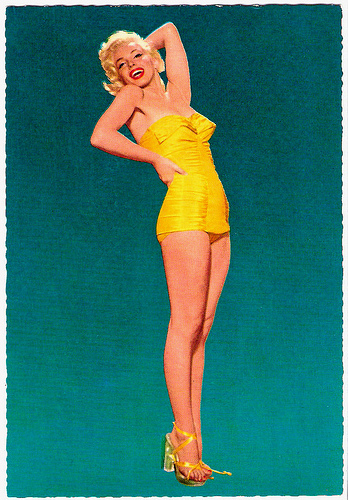
German postcard by ISV, Sort. VI/6.
Cheesecake queen turned box office smash
Marilyn Monroe was born Norma Jeane Mortenson in 1926 in Lemmon, South Dakota. She was the third child of Gladys Pearl Baker née Monroe, who suffered from mental illness and later worked as a film-cutter at RKO. Marilyn was abandoned by her mother and she spent most of her childhood in foster homes and an orphanage.
Just after her 16th birthday, she married 21-year-old aircraft plant worker James 'Jim' Dougherty. In 1943, Dougherty enlisted in the Merchant Marine. He was initially stationed on Catalina Island, where she lived with him until he was shipped out to the Pacific in April 1944; he would remain there for most of the next two years.
While working in a factory as part of the war effort in 1944, Marilyn met photographer David Conover and began a successful modeling career. She began to occasionally use the name Jean Norman when working, and had her curly brunette hair straightened and dyed blond to make her more employable. As her figure was deemed more suitable for pin-up than fashion modeling, she was employed mostly for advertisements and men's magazines. By early 1946, she had appeared on 33 magazine covers for publications such as Pageant, U.S. Camera, Laff, and Peek. She divorced Dougherty in 1946.
The work led to a screentest by 20th Century Fox executive and former film star Ben Lyon. Head executive Darryl F. Zanuck was unenthusiastic about it, but he was persuaded to give her a standard six-month contract to avoid her being signed by rival studio RKO Pictures. Monroe began her contract in August 1946, and together with Lyon selected the screen name of Marilyn Monroe. Among her first film parts were nine lines of dialogue as a waitress in the drama Dangerous Years (Arthur Pierson, 1947) and a one-line appearance in the comedy Scudda Hoo! Scudda Hay! (F. Hugh Herbert, 1948). After a series of other minor film roles, she moved to Columbia.
While at Fox her roles had been that of a 'girl next door', at Columbia she was modeled after Rita Hayworth . Monroe's hairline was raised by electrolysis and her hair was bleached even lighter, to platinum blond. She also began working with the studio's head drama coach, Natasha Lytess, who would remain her mentor until 1955. Her only film at the studio was the low-budget musical Ladies of the Chorus (Phil Karlson, 1948), in which she had her first starring role as a chorus girl who is courted by a wealthy man.
After leaving Columbia in September 1948, Monroe became a protégée of Johnny Hyde, vice president of the William Morris Agency. Hyde began representing her and their relationship soon became sexual, although she refused his proposals of marriage. To advance Monroe's career, he paid for a silicone prosthesis to be implanted in her jaw, and arranged a bit part in the Marx Brothers film Love Happy (David Miller, 1949). That year, she also made minor appearances in two critically acclaimed films: John Huston's crime film The Asphalt Jungle (1950) and Joseph Mankiewicz's drama All About Eve (1950). Following Monroe's success in these roles, Hyde negotiated a seven-year contract with 20th Century-Fox in December 1950.
Over the next two years, she became a popular actress with roles in several comedies, including As Young as You Feel (Harmon Jones, 1951) and Monkey Business (Howard Hawks, 1952) with Cary Grant, and in the dramas Clash by Night (Fritz Lang, 1952) and Don't Bother to Knock (Roy Ward Baker, 1952) with Richard Widmark. Her popularity with audiences was growing: she received several thousand letters of fan mail a week.
The second year of the Fox contract saw Monroe become a top-billed actress, with gossip columnist Florabel Muir naming her the year's 'it girl' and Hedda Hopper describing her as the 'cheesecake queen' turned 'box office smash'. She began a highly publicized romance with retired New York Yankee baseball legend Joe DiMaggio, one of the most famous sports personalities of the era. A month later, Monroe faced a scandal when it was revealed that she had posed for nude photos before becoming a star, but rather than damaging her career, the story increased interest in her films.
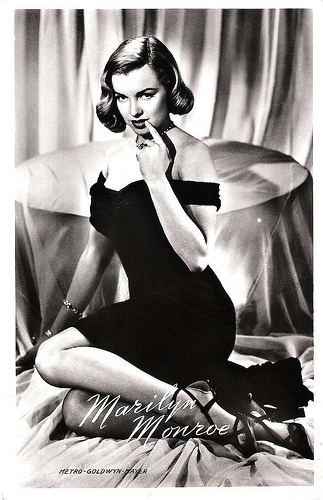
Dutch postcard by Uitg. Takken, Utrecht, no. 1708. Photo: Metro-Goldwyn-Mayer. Publicity still for The Asphalt Jungle (John Huston, 1950).
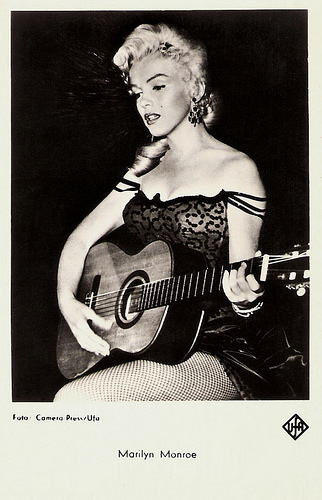
French postcard by Editions P.I., Paris, no. FK 3969. Photo: Camera Press / Ufa. Publicity still for River of No Return (Otto Preminger, 1954).
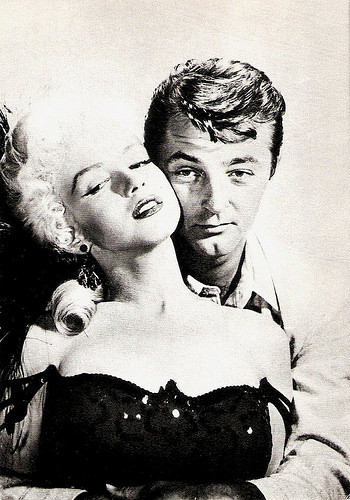
Vintage postcard. Photo: publicity still for River of No Return (Otto Preminger, 1954), with Robert Mitchum.
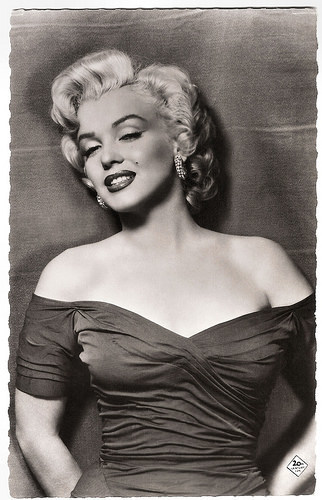
French postcard by Editions P.I., offered by Les Carbones Korès Carboplane, mo. 882. Photo: 20th Century Fox.
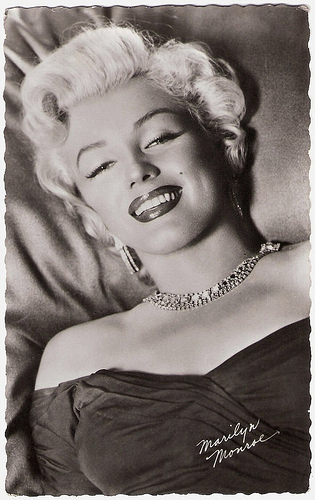
Dutch postcard by Int. Filmpers (IFP), Amsterdam, no. 1154.
More control and a larger salary
By 1953, Marilyn Monroe was one of the most marketable Hollywood stars with leading roles in three hits: the Film Noir Niagara, and the comedies Gentlemen Prefer Blondes and How to Marry a Millionaire. In Niagara (Henry Hathaway, 1953), she played a femme fatale scheming to murder her husband, played by Joseph Cotten.
While Niagara made Monroe a sex symbol, the satirical musical comedy Gentlemen Prefer Blondes (Howard Hawks, 1953), established her screen persona as a 'dumb blonde'. Based on Anita Loos' bestselling novel and its Broadway version, the film focuses on two 'gold-digging' showgirls, Lorelei Lee and Dorothy Shaw, played by Monroe and Jane Russell. It became one of the biggest box office successes of the year by grossing $5.3 million, more than double its production costs.
Her next film, How to Marry a Millionaire (Jean Negulesco, 1953), co-starred Betty Grable and Lauren Bacall. It featured Monroe in the role of a naïve model who teams up with her friends to find rich husbands, repeating the successful formula of Gentlemen Prefer Blondes. Despite mixed reviews, the film was Monroe's biggest box office success so far, earning $8 million in world rentals.
Although she played a significant role in the creation and management of her public image throughout her career, she was disappointed at being typecast and underpaid by the studio. She was suspended in early 1954 for refusing a film project. The suspension was front page news and Monroe immediately began a publicity campaign to counter any negative press and to strengthen her position in the conflict. On 14 January, she and Joe DiMaggio were married at the San Francisco City Hall. They then traveled to Japan, combining a honeymoon with his business trip. From there, she traveled alone to Korea, where she performed songs from her films as part of a USO show for over 60,000 U.S. Marines over a four-day period.
She settled with Fox and returned to star in one of the biggest box office successes of her career, The Seven Year Itch (Billy Wilder, 1955). Then followed the release of Otto Preminger's Western River of No Return (1955), in which Monroe appeared opposite Robert Mitchum. When the studio was still reluctant to change her contract, Monroe and photographer Milton Greene founded a film production company in late 1954, Marilyn Monroe Productions (MMP). She dedicated 1955 to building her company and began studying method acting at the Actors Studio. She grew close to the studio's director, Lee Strasberg and to his wife Paula, receiving private lessons at their home due to her shyness, and she soon became like a family member.
In late 1955, Fox awarded her a new contract, which gave her more control and a larger salary. Monroe did a critically acclaimed performance in Bus Stop (Joshua Logan, 1956). She played Chérie, a saloon singer whose dreams of stardom are complicated by a naïve cowboy who falls in love with her. She received a Golden Globe for Best Actress nomination for her performance. Then she acted opposite Laurence Olivier in the first independent production of MMP, The Prince and the Showgirl (Laurence Olivier, 1957), made in Great Britain. It was released in June 1957 to mixed reviews, and proved unpopular with American audiences. The film was better received in Europe where it won Crystal Star awards, and was nominated for a BAFTA.
Then she acted opposite Jack Lemmon and Tony Curtis in the classic comedy Some Like It Hot (Billy Wilder, 1959). The film was an absolute smash hit, with Curtis and Lemmon pretending to be females in an all-girl band, so they can get work. This was to be Marilyn's only film for the year. She won a Golden Globe for Best Actress for role.
Monroe took a hiatus until late 1959, when she returned to Hollywood to star in the musical comedy Let's Make Love (George Cukor, 1960), about an actress and a millionaire ( Yves Montand ) who fall in love when performing in a satirical play. Her affair with Montand was widely reported by the press and used in the film's publicity campaign. Her last completed film was the drama The Misfits (John Huston, 1961), which Arthur Miller had written to provide her with a dramatic role. She played a recently divorced woman who becomes friends with three aging cowboys, played by Clark Gable, Eli Wallach and Montgomery Clift.
Monroe returned to the public eye in spring 1962: she received a 'World Film Favorite' Golden Globe award and began to shoot a new film for 20th Century-Fox, Something's Got to Give, a re-make of My Favorite Wife (Garson Kanin, 1940). Days before filming began, Monroe caught sinusitis; despite medical advice to postpone the production, Fox began it as planned in late April. Monroe was too ill to work for the majority of the next six weeks, but despite confirmations by multiple doctors, the studio tried to put pressure on her by alleging publicly that she was faking it.
On 19 May 1962, she took a break to sing Happy Birthday on stage at President John F. Kennedy's birthday celebration at Madison Square Garden in New York. She drew attention with her costume: a beige, skintight dress covered in rhinestones, which made her appear nude. Monroe next filmed a scene for Something's Got to Give in which she swam naked in a swimming pool. To generate advance publicity, the press were invited to take photographs of the scene, which were later published in Life. It was the first time that a major star had posed nude while at the height of their career. When she was again on sick leave for several days, Fox decided that it could not afford to have another film running behind schedule when it was already struggling to cover the rising costs of Cleopatra (Joseph L. Mankiewicz, 1963). The studio blamed Monroe for the film's demise and began spreading negative publicity about her, even alleging that she was mentally disturbed.
Fox soon regretted its decision, and re-opened negotiations with Monroe later in June; a settlement about a new contract, including re-commencing Something's Got to Give and a starring role in the black comedy What a Way to Go! (J. Lee Thompson, 1964), was reached later that summer. To repair her public image, Monroe engaged in several publicity ventures, including interviews for Life and Cosmopolitan and her first photo shoot for Vogue. For Vogue, she and photographer Bert Stern collaborated for two series of photographs, one a standard fashion editorial and another of her posing nude, which were both later published posthumously with the title The Last Sitting. In the last weeks of her life, she was also planning on starring in a biopic of Jean Harlow.
Only 36, Marilyn Monroe died on 5 August 1962 from an overdose of barbiturates. She was discovered dead at her home at 12305 Fifth Helena Drive in Brentwood. She had a phone in one of her hands, her body was completely nude and face down, on her bed. During her life and also after her death, her troubled private life received much attention. She struggled with addiction, depression, and anxiety. She had two highly publicized marriages, to baseball player Joe DiMaggio and playwright Arthur Miller, which both ended in divorce. Although the death was ruled a probable suicide, several conspiracy theories have been proposed in the decades following her death. There are over 600 books written about her.
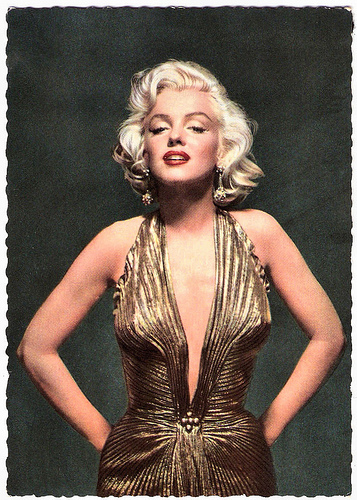
German postcard by Universum-Film Aktiengesellschaft (Ufa), Berlin-Tempelhof, no. CK-73. Photo: Gene Korman / 20th Century Fox, 1953.
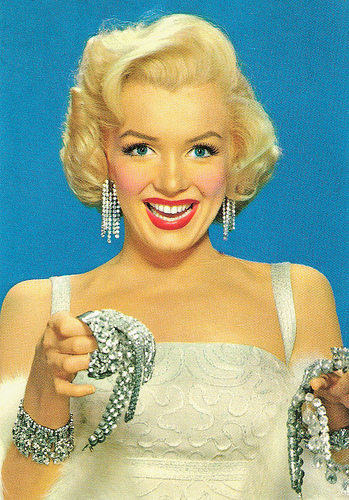
British postcard by Santoro Graphics, London, no. C213. Photo: publicity still for Gentlemen Prefer Blondes (Howard Hawks, 1953).
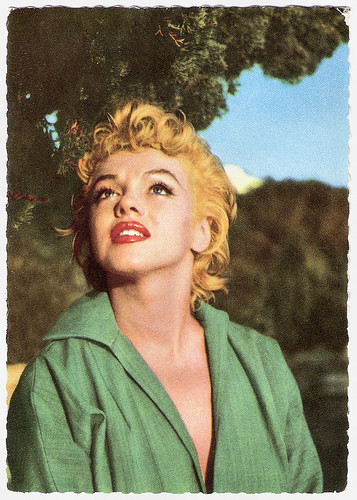
West-German postcard by Ufa, Berlin-Tempelhof, no. CK-10. Photo: Baron Studios, London. Sterling Henry Nahum, known professionally as Baron, was a society and court photographer in the United Kingdom. However, one notable sitter was Marilyn Monroe, whom in 1954 he went to California to photograph in an outdoor shoot in Palm Springs.
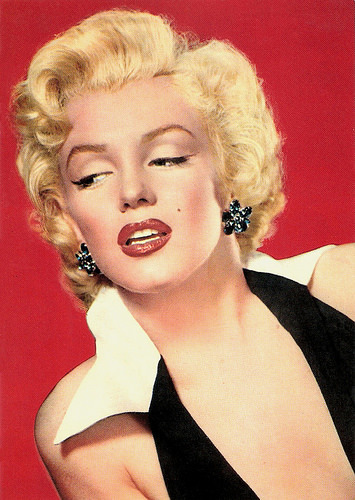
French postcard by Edition P.I., Paris, no. 1044.
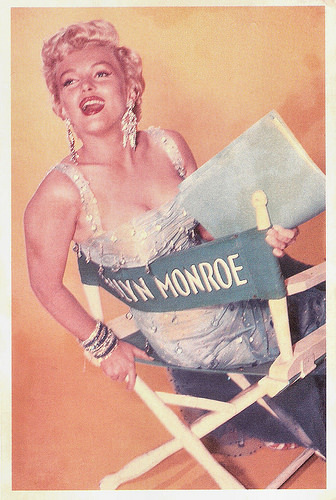
American postcard by The American Postcard Company, no. 282, 1981. Photo: Bruno Bernard (Bernard of Hollywood).
The Nude Calendar
Before posing for her famous calendar shots taken by photographer Tom Kelley, Marilyn had turned down many offers to pose nude. It seems she accepted only when her need was dire and immediate. Early 1949, her contracts with 20th Century Fox and Columbia had not been renewed, she was out of work, and had a certain level of lifestyle to maintain. The $50 she was paid was exactly what she needed to get back her car which had been impounded.
The photographs that became the infamous 'Golden Dreams' calendar were taken on 27 May 1949. Kelley's wife Natalie helped to prepare the red velvet backdrop and the cameras. The shoot lasted two hours while Kelley shot a sequence of photographs from a ten-foot ladder. Only two of the twenty-four shots Kelley took actually made it to print. 'A New Wrinkle' (pictured here) graced one Braugarth Company calendar, but the picture that captured a nation's imagination was 'Golden Dreams'.
The story that Hollywood's hottest new property Marilyn Monroe was in fact the girl in the nude calendar was broken by wire journalist Aline Mosby in March 1952. The studio's initial reaction was to deny everything. No Hollywood star had ever been proven to have done such a thing; the early fifties was a time of strait-laced public morals. Biographers agree that Marilyn was instrumental in persuading the studio that their natural inclination to deny the whole thing was the wrong way to handle it. An exclusive interview was arranged and the following confession ran in US newspapers on 13 March 1952.
MARILYN MONROE ADMITS SHE'S NUDE BLONDE OF CALENDAR
A photograph of a beautiful nude blonde on a 1952 calendar is hanging in garages and barbershops all over the nation today. Marilyn Monroe admitted today that the beauty is she. She posed, stretched out on rumpled red velvet for the artistic photo 3 years ago because "I was broke and needed the money".
"Oh, the calendar's hanging in garages all over town," said Marilyn. "Why deny it? You can get one any place. Besides, I'm not ashamed of it. I've done nothing wrong."
The beautiful blonde now gets a fat pay check every week from an excited Twentieth Century-Fox studio. She's rated the most sensational sweater girl since Lana Turner....she lives in an expensive hotel room...She dines at Romanoff's. But in 1949 she was just another scared young blonde, struggling to find fame in the magic city, and all alone. As a child she lived in a Hollywood orphanage. She was pushed around among twelve sets of foster parents before she turned an insecure sixteen.
"I was a week behind on my rent," she explained. "I had to have the money. A photographer, Tom Kelley, had asked me before to pose but I'd never do it. This time I called him and said I would. Tom didn't think anyone would recognize me. My hair was long then. But when the picture came out, everybody knew me. I'd never have done it if I'd known things would happen in Hollywood so fast for me."
In the aftermath of the calendar confession, Marilyn was harangued by journalists. In typical fashion, when asked if it was true she had nothing on when she posed, she replied "Oh no, I had the radio on."
In December 1953 a man named Hugh Hefner bought the rights to reproduce the 'Golden Dreams' photograph as the first centrefold in the first ever issue of Playboy magazine.
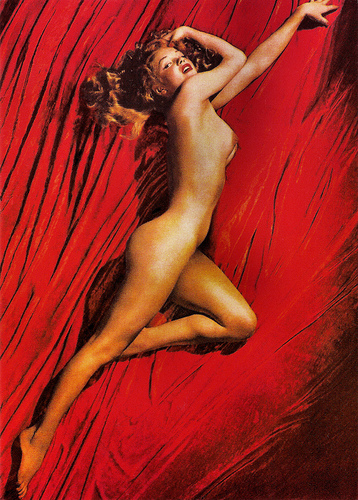
Modern postcard. Photo: Tom Kelley.
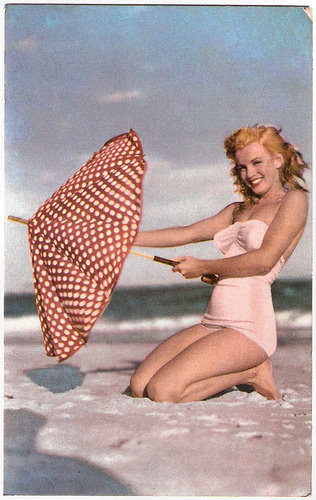
French postcard by JG, Paris, no. 603/5. Photo: Andre de Dienes, 1949.
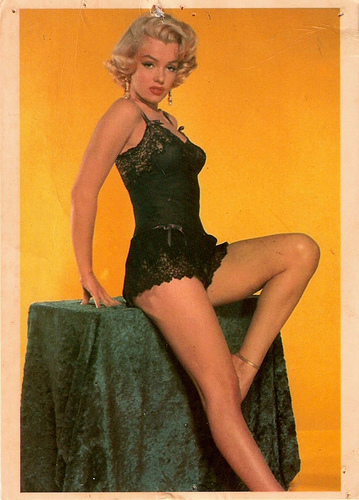
British postcard by Camden Graphics, nr. PC 443. Photo: Frank Powolny, 1951.
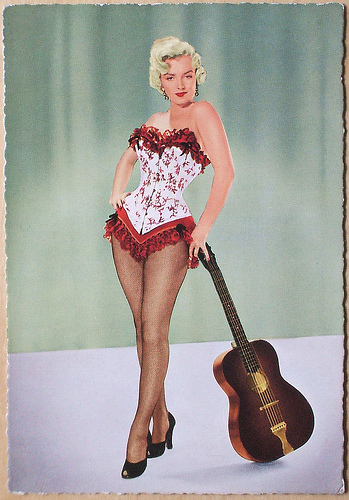
Vintage postcard, no. PU 13. Photo: publicity still for The River of No Return (Otto Preminger, 1953). Collection: Meiter.
Sources: De Nieuwe Kerk, Marilyn Geek, and Wikipedia.

German postcard by ISV, Sort. VI/6.

Italian postcard by Rotalcolor, Milano, no. 36. Photo: publicity still for Niagara (Henry Hathaway, 1953).

West-German postcard by Krüger, no. 902/13. Photo: publicity still for Gentlemen Prefer Blondes (Howard Hawks, 1953).

Spanish postcard by Archivo Bermejo, no. 7. Photo: 20th Century Fox. Publicity still for River of No Return (Otto Preminger, 1954).

German postcard by ISV, Sort. VI/6.
Cheesecake queen turned box office smash
Marilyn Monroe was born Norma Jeane Mortenson in 1926 in Lemmon, South Dakota. She was the third child of Gladys Pearl Baker née Monroe, who suffered from mental illness and later worked as a film-cutter at RKO. Marilyn was abandoned by her mother and she spent most of her childhood in foster homes and an orphanage.
Just after her 16th birthday, she married 21-year-old aircraft plant worker James 'Jim' Dougherty. In 1943, Dougherty enlisted in the Merchant Marine. He was initially stationed on Catalina Island, where she lived with him until he was shipped out to the Pacific in April 1944; he would remain there for most of the next two years.
While working in a factory as part of the war effort in 1944, Marilyn met photographer David Conover and began a successful modeling career. She began to occasionally use the name Jean Norman when working, and had her curly brunette hair straightened and dyed blond to make her more employable. As her figure was deemed more suitable for pin-up than fashion modeling, she was employed mostly for advertisements and men's magazines. By early 1946, she had appeared on 33 magazine covers for publications such as Pageant, U.S. Camera, Laff, and Peek. She divorced Dougherty in 1946.
The work led to a screentest by 20th Century Fox executive and former film star Ben Lyon. Head executive Darryl F. Zanuck was unenthusiastic about it, but he was persuaded to give her a standard six-month contract to avoid her being signed by rival studio RKO Pictures. Monroe began her contract in August 1946, and together with Lyon selected the screen name of Marilyn Monroe. Among her first film parts were nine lines of dialogue as a waitress in the drama Dangerous Years (Arthur Pierson, 1947) and a one-line appearance in the comedy Scudda Hoo! Scudda Hay! (F. Hugh Herbert, 1948). After a series of other minor film roles, she moved to Columbia.
While at Fox her roles had been that of a 'girl next door', at Columbia she was modeled after Rita Hayworth . Monroe's hairline was raised by electrolysis and her hair was bleached even lighter, to platinum blond. She also began working with the studio's head drama coach, Natasha Lytess, who would remain her mentor until 1955. Her only film at the studio was the low-budget musical Ladies of the Chorus (Phil Karlson, 1948), in which she had her first starring role as a chorus girl who is courted by a wealthy man.
After leaving Columbia in September 1948, Monroe became a protégée of Johnny Hyde, vice president of the William Morris Agency. Hyde began representing her and their relationship soon became sexual, although she refused his proposals of marriage. To advance Monroe's career, he paid for a silicone prosthesis to be implanted in her jaw, and arranged a bit part in the Marx Brothers film Love Happy (David Miller, 1949). That year, she also made minor appearances in two critically acclaimed films: John Huston's crime film The Asphalt Jungle (1950) and Joseph Mankiewicz's drama All About Eve (1950). Following Monroe's success in these roles, Hyde negotiated a seven-year contract with 20th Century-Fox in December 1950.
Over the next two years, she became a popular actress with roles in several comedies, including As Young as You Feel (Harmon Jones, 1951) and Monkey Business (Howard Hawks, 1952) with Cary Grant, and in the dramas Clash by Night (Fritz Lang, 1952) and Don't Bother to Knock (Roy Ward Baker, 1952) with Richard Widmark. Her popularity with audiences was growing: she received several thousand letters of fan mail a week.
The second year of the Fox contract saw Monroe become a top-billed actress, with gossip columnist Florabel Muir naming her the year's 'it girl' and Hedda Hopper describing her as the 'cheesecake queen' turned 'box office smash'. She began a highly publicized romance with retired New York Yankee baseball legend Joe DiMaggio, one of the most famous sports personalities of the era. A month later, Monroe faced a scandal when it was revealed that she had posed for nude photos before becoming a star, but rather than damaging her career, the story increased interest in her films.

Dutch postcard by Uitg. Takken, Utrecht, no. 1708. Photo: Metro-Goldwyn-Mayer. Publicity still for The Asphalt Jungle (John Huston, 1950).

French postcard by Editions P.I., Paris, no. FK 3969. Photo: Camera Press / Ufa. Publicity still for River of No Return (Otto Preminger, 1954).

Vintage postcard. Photo: publicity still for River of No Return (Otto Preminger, 1954), with Robert Mitchum.

French postcard by Editions P.I., offered by Les Carbones Korès Carboplane, mo. 882. Photo: 20th Century Fox.

Dutch postcard by Int. Filmpers (IFP), Amsterdam, no. 1154.
More control and a larger salary
By 1953, Marilyn Monroe was one of the most marketable Hollywood stars with leading roles in three hits: the Film Noir Niagara, and the comedies Gentlemen Prefer Blondes and How to Marry a Millionaire. In Niagara (Henry Hathaway, 1953), she played a femme fatale scheming to murder her husband, played by Joseph Cotten.
While Niagara made Monroe a sex symbol, the satirical musical comedy Gentlemen Prefer Blondes (Howard Hawks, 1953), established her screen persona as a 'dumb blonde'. Based on Anita Loos' bestselling novel and its Broadway version, the film focuses on two 'gold-digging' showgirls, Lorelei Lee and Dorothy Shaw, played by Monroe and Jane Russell. It became one of the biggest box office successes of the year by grossing $5.3 million, more than double its production costs.
Her next film, How to Marry a Millionaire (Jean Negulesco, 1953), co-starred Betty Grable and Lauren Bacall. It featured Monroe in the role of a naïve model who teams up with her friends to find rich husbands, repeating the successful formula of Gentlemen Prefer Blondes. Despite mixed reviews, the film was Monroe's biggest box office success so far, earning $8 million in world rentals.
Although she played a significant role in the creation and management of her public image throughout her career, she was disappointed at being typecast and underpaid by the studio. She was suspended in early 1954 for refusing a film project. The suspension was front page news and Monroe immediately began a publicity campaign to counter any negative press and to strengthen her position in the conflict. On 14 January, she and Joe DiMaggio were married at the San Francisco City Hall. They then traveled to Japan, combining a honeymoon with his business trip. From there, she traveled alone to Korea, where she performed songs from her films as part of a USO show for over 60,000 U.S. Marines over a four-day period.
She settled with Fox and returned to star in one of the biggest box office successes of her career, The Seven Year Itch (Billy Wilder, 1955). Then followed the release of Otto Preminger's Western River of No Return (1955), in which Monroe appeared opposite Robert Mitchum. When the studio was still reluctant to change her contract, Monroe and photographer Milton Greene founded a film production company in late 1954, Marilyn Monroe Productions (MMP). She dedicated 1955 to building her company and began studying method acting at the Actors Studio. She grew close to the studio's director, Lee Strasberg and to his wife Paula, receiving private lessons at their home due to her shyness, and she soon became like a family member.
In late 1955, Fox awarded her a new contract, which gave her more control and a larger salary. Monroe did a critically acclaimed performance in Bus Stop (Joshua Logan, 1956). She played Chérie, a saloon singer whose dreams of stardom are complicated by a naïve cowboy who falls in love with her. She received a Golden Globe for Best Actress nomination for her performance. Then she acted opposite Laurence Olivier in the first independent production of MMP, The Prince and the Showgirl (Laurence Olivier, 1957), made in Great Britain. It was released in June 1957 to mixed reviews, and proved unpopular with American audiences. The film was better received in Europe where it won Crystal Star awards, and was nominated for a BAFTA.
Then she acted opposite Jack Lemmon and Tony Curtis in the classic comedy Some Like It Hot (Billy Wilder, 1959). The film was an absolute smash hit, with Curtis and Lemmon pretending to be females in an all-girl band, so they can get work. This was to be Marilyn's only film for the year. She won a Golden Globe for Best Actress for role.
Monroe took a hiatus until late 1959, when she returned to Hollywood to star in the musical comedy Let's Make Love (George Cukor, 1960), about an actress and a millionaire ( Yves Montand ) who fall in love when performing in a satirical play. Her affair with Montand was widely reported by the press and used in the film's publicity campaign. Her last completed film was the drama The Misfits (John Huston, 1961), which Arthur Miller had written to provide her with a dramatic role. She played a recently divorced woman who becomes friends with three aging cowboys, played by Clark Gable, Eli Wallach and Montgomery Clift.
Monroe returned to the public eye in spring 1962: she received a 'World Film Favorite' Golden Globe award and began to shoot a new film for 20th Century-Fox, Something's Got to Give, a re-make of My Favorite Wife (Garson Kanin, 1940). Days before filming began, Monroe caught sinusitis; despite medical advice to postpone the production, Fox began it as planned in late April. Monroe was too ill to work for the majority of the next six weeks, but despite confirmations by multiple doctors, the studio tried to put pressure on her by alleging publicly that she was faking it.
On 19 May 1962, she took a break to sing Happy Birthday on stage at President John F. Kennedy's birthday celebration at Madison Square Garden in New York. She drew attention with her costume: a beige, skintight dress covered in rhinestones, which made her appear nude. Monroe next filmed a scene for Something's Got to Give in which she swam naked in a swimming pool. To generate advance publicity, the press were invited to take photographs of the scene, which were later published in Life. It was the first time that a major star had posed nude while at the height of their career. When she was again on sick leave for several days, Fox decided that it could not afford to have another film running behind schedule when it was already struggling to cover the rising costs of Cleopatra (Joseph L. Mankiewicz, 1963). The studio blamed Monroe for the film's demise and began spreading negative publicity about her, even alleging that she was mentally disturbed.
Fox soon regretted its decision, and re-opened negotiations with Monroe later in June; a settlement about a new contract, including re-commencing Something's Got to Give and a starring role in the black comedy What a Way to Go! (J. Lee Thompson, 1964), was reached later that summer. To repair her public image, Monroe engaged in several publicity ventures, including interviews for Life and Cosmopolitan and her first photo shoot for Vogue. For Vogue, she and photographer Bert Stern collaborated for two series of photographs, one a standard fashion editorial and another of her posing nude, which were both later published posthumously with the title The Last Sitting. In the last weeks of her life, she was also planning on starring in a biopic of Jean Harlow.
Only 36, Marilyn Monroe died on 5 August 1962 from an overdose of barbiturates. She was discovered dead at her home at 12305 Fifth Helena Drive in Brentwood. She had a phone in one of her hands, her body was completely nude and face down, on her bed. During her life and also after her death, her troubled private life received much attention. She struggled with addiction, depression, and anxiety. She had two highly publicized marriages, to baseball player Joe DiMaggio and playwright Arthur Miller, which both ended in divorce. Although the death was ruled a probable suicide, several conspiracy theories have been proposed in the decades following her death. There are over 600 books written about her.

German postcard by Universum-Film Aktiengesellschaft (Ufa), Berlin-Tempelhof, no. CK-73. Photo: Gene Korman / 20th Century Fox, 1953.

British postcard by Santoro Graphics, London, no. C213. Photo: publicity still for Gentlemen Prefer Blondes (Howard Hawks, 1953).

West-German postcard by Ufa, Berlin-Tempelhof, no. CK-10. Photo: Baron Studios, London. Sterling Henry Nahum, known professionally as Baron, was a society and court photographer in the United Kingdom. However, one notable sitter was Marilyn Monroe, whom in 1954 he went to California to photograph in an outdoor shoot in Palm Springs.

French postcard by Edition P.I., Paris, no. 1044.

American postcard by The American Postcard Company, no. 282, 1981. Photo: Bruno Bernard (Bernard of Hollywood).
The Nude Calendar
Before posing for her famous calendar shots taken by photographer Tom Kelley, Marilyn had turned down many offers to pose nude. It seems she accepted only when her need was dire and immediate. Early 1949, her contracts with 20th Century Fox and Columbia had not been renewed, she was out of work, and had a certain level of lifestyle to maintain. The $50 she was paid was exactly what she needed to get back her car which had been impounded.
The photographs that became the infamous 'Golden Dreams' calendar were taken on 27 May 1949. Kelley's wife Natalie helped to prepare the red velvet backdrop and the cameras. The shoot lasted two hours while Kelley shot a sequence of photographs from a ten-foot ladder. Only two of the twenty-four shots Kelley took actually made it to print. 'A New Wrinkle' (pictured here) graced one Braugarth Company calendar, but the picture that captured a nation's imagination was 'Golden Dreams'.
The story that Hollywood's hottest new property Marilyn Monroe was in fact the girl in the nude calendar was broken by wire journalist Aline Mosby in March 1952. The studio's initial reaction was to deny everything. No Hollywood star had ever been proven to have done such a thing; the early fifties was a time of strait-laced public morals. Biographers agree that Marilyn was instrumental in persuading the studio that their natural inclination to deny the whole thing was the wrong way to handle it. An exclusive interview was arranged and the following confession ran in US newspapers on 13 March 1952.
MARILYN MONROE ADMITS SHE'S NUDE BLONDE OF CALENDAR
A photograph of a beautiful nude blonde on a 1952 calendar is hanging in garages and barbershops all over the nation today. Marilyn Monroe admitted today that the beauty is she. She posed, stretched out on rumpled red velvet for the artistic photo 3 years ago because "I was broke and needed the money".
"Oh, the calendar's hanging in garages all over town," said Marilyn. "Why deny it? You can get one any place. Besides, I'm not ashamed of it. I've done nothing wrong."
The beautiful blonde now gets a fat pay check every week from an excited Twentieth Century-Fox studio. She's rated the most sensational sweater girl since Lana Turner....she lives in an expensive hotel room...She dines at Romanoff's. But in 1949 she was just another scared young blonde, struggling to find fame in the magic city, and all alone. As a child she lived in a Hollywood orphanage. She was pushed around among twelve sets of foster parents before she turned an insecure sixteen.
"I was a week behind on my rent," she explained. "I had to have the money. A photographer, Tom Kelley, had asked me before to pose but I'd never do it. This time I called him and said I would. Tom didn't think anyone would recognize me. My hair was long then. But when the picture came out, everybody knew me. I'd never have done it if I'd known things would happen in Hollywood so fast for me."
In the aftermath of the calendar confession, Marilyn was harangued by journalists. In typical fashion, when asked if it was true she had nothing on when she posed, she replied "Oh no, I had the radio on."
In December 1953 a man named Hugh Hefner bought the rights to reproduce the 'Golden Dreams' photograph as the first centrefold in the first ever issue of Playboy magazine.

Modern postcard. Photo: Tom Kelley.

French postcard by JG, Paris, no. 603/5. Photo: Andre de Dienes, 1949.

British postcard by Camden Graphics, nr. PC 443. Photo: Frank Powolny, 1951.

Vintage postcard, no. PU 13. Photo: publicity still for The River of No Return (Otto Preminger, 1953). Collection: Meiter.
Sources: De Nieuwe Kerk, Marilyn Geek, and Wikipedia.
Published on October 14, 2016 22:00
October 13, 2016
EFSP's Dazzling Dozen: Beauty Queens
Beauty contests became popular in the 1880s, but were not regarded as respectable. The pageants came to be considered more respectable with the first modern Miss America contest held in 1921. Beauty contests lead to many film careers. Some careers were tragically short, others were enduringly successful. Today EFSP presents 12 postcards of dazzling European beauty queens who acted in films.
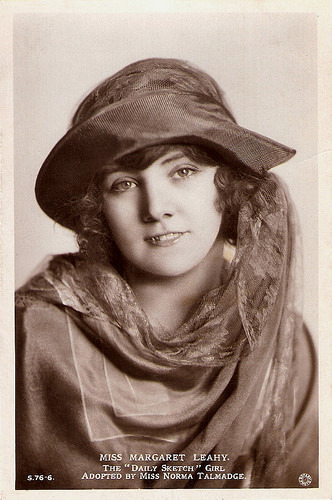
British postcard by Rotary Photo, London, no. 5.76. 6. Caption: The Daily Sketch girl. Adopted by Miss Norma Talmadge.
Margaret Leahy (1902–1967) won a beauty contest of the British Daily Sketch. In 1922, a starring role in a major Hollywood film was offered by the newspaper in a grand and widely publicised film star competition. The competition was to find a British actress to play second lead in Norma Talmadge's forthcoming Hollywood production Within The Law. The contestants reputably numbered nearly 80,000 and the competition resulted in three girls thought suitable: Katherine Campbell, the French Agnès Souret and Leahy. Prior to depart to Hollywood, Leahy toured several major cities in Europe and was greeted with hundreds of cheering fans and photographers as the new film star that was about to be born.
In Hollywood, Margaret Leahy began working with director Frank Lloyd who was going to make her a 'star.' Although it was said by her publicity that the young beauty queen had acted in English and French films, this proved to be highly untrue. Lloyd had her dismissed from Within the Law (1923). He claimed that Leahy could do nothing that an actress was supposed to be able to do. Following this, producer Joseph Schenck believed it did not take much to be a comedian, and handed Margaret over to his brother-in-law Buster Keaton to appear in his next comedy, the silent feature Three Ages (Edward F. Cline, Buster Keaton, 1923). Leahy's only film did absolutely nothing to improve her already crumbling film career. After the film finished shooting, there were no attempts to put her in any other films as she was labeled as being untalented and incapable of learning how to act. She went so far as to sue Joseph Schenck for $50,000 for breach of contract and injured feelings. Leahy chose to remain in California and get married, instead of returning to England.
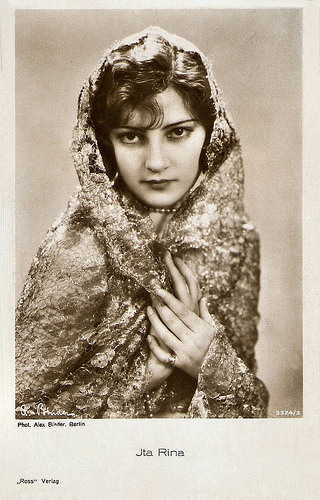
German postcard by Ross Verlag, no. 3324/3, 1928-1929. Photo: Alex Binder, Berlin.
Yugoslav film actress and beauty queen Ita Rina (1907-1979) was one of the major film stars in Germany and Czechoslovakia in the late 1920s and early 1930s. In October 1926, Slavic People magazine organised a beauty pageant for a Miss to represent Yugoslavia at the Miss Europe contest. The attractive nineteen-year-old Rina secretly entered the beauty contest, not telling anyone at home. She was crowned Miss Slovenia and should travel to the final event for Miss Yugoslavia in Zagreb. Then her mother forbade her go to Zagreb. However, she was noticed by Adolf Müller, the owner of Balkan Palace cinema in Zagreb. He sent her photographs to German film producer Peter Ostermayer, who invited her to come to Germany. As her mother did not want to let her go to Berlin, Rina ran away from home and arrived in Berlin in 1927. After her first audition, she had classes in acting, diction, dancing, driving and riding.
Ita Rina made her film debut in the leading role in Was die Kinder ihren Eltern verschweigen/What Do Children Hide from Their Parents (Franz Osten, 1927) with Mary Johnson. The critics noticed her in Das letzte Souper/The Last Supper (Mario Bonnard, 1928). Her big breakthrough came the following year in Erotikon/Seduction (1929), directed by Gustav Machatý. The film was a great success but also upset some moral and Christian organizations. In 1931, Ita Rina earned 15,000 marks per month and was an idol to teenagers as well as modern emancipated women. The same year, Rina was given an offer from Hollywood, but her husband forced her to choose between her career and their marriage; Rina chose to stay with him. Although she had announced her retirement from the cinema, she acted until the outbreak of the World War II.
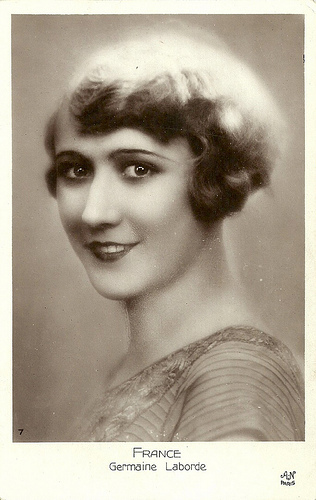
French postcard by A.N., Paris. Caption: France - Germaine Laborde
Germaine Laborde was Miss France 1928, after being elected Miss Gascogne in 1927. She joined the 1929 Miss Europe contest but didn't win; she became third after Hungary and Poland. On her return to France, Mlle. Laborde played with Mistinguett at the Casino de Paris in the revue, Paris-Miss. Laborde also acted in the film Chacun sa chance by René Pujol and Hanns Steinhoff, starring Renée Heribel and Jean Gabin . Her career didn't last very long and she became a nanny.
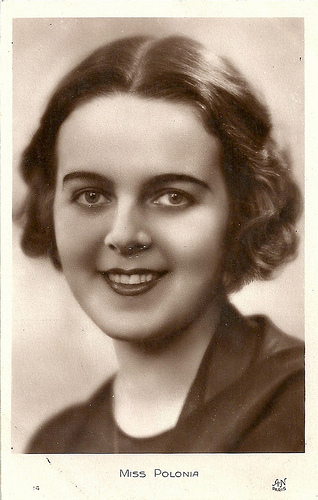
French postcard by A.N., Paris, no. 14. Caption: Miss Polonia.
Polish model and actress Zofia Batycka (1907-1989) studied at the Warsaw School of Economics. She supposedly had an affair with tenor Jan Kiepura in 1928 but they never married. As a student Zofia made her debut in the cinema. From 1929 on she played in Polish films, first in the silent Sfinks production Grzeszna milosc (Zbigniew Gniazdowski, Mieczyslaw Krawicz, 1929), partly filmed at the Tatra Mountains. It was followed by the silent films Szlakiem hanby/Export in Blond (Mieczyslaw Krawicz, Alfred Niemirski, 1929) and Dusze w niewoli/Souls in Bondage (Leon Trystan, 1930). Moralnosc pani Dulskiej (Boleslaw Newolin, 1930) was probably her first sound film. It was followed by the short sound film Kobieta, która sie smieje (Ryszard Ordynski, 1931) which was shot at the Paris Paramount sound studios, and the sound feature Dziesieciu z Pawiaka/10 Condemned (Ryszard Ordynski, 1931).
When Zofia Batycka won the title of Miss Polonia 1930, she became extremely popular. She joined the Miss Europe 1930 contest in Paris. Winner that year was Miss Greece Aliki Diplarakou. Batycka went on to win the title of Miss Paramount in 1931 and went to Hollywood in hope of a film career there. While away, Miss Poland 1931 couldn't go through as Batycka had forgotten to hand over the temporary crown. In 1932, Batycka signed with the American label International Artists. It proved to be completely unsuccessful - in fact she didn't do any movies in Hollywood. In 1934 she returned to Poland and for a time there she worked as a theatre actress. Soon she gave up acting and married. After the war she moved to the United States and settled in Los Angeles. After her husband's death and that of her mother, she maintained herself by teaching foreign languages (she mastered four languages), and then worked in a gallery. She died in obscurity in 1989.
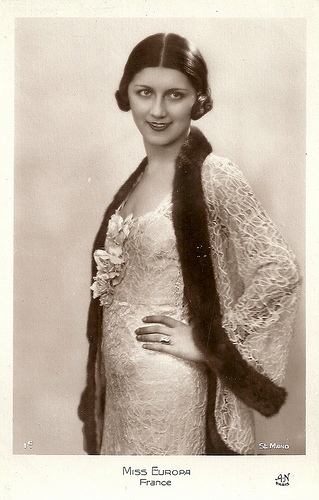
French postcard by A.N., Paris, no. 1c. Photo: St. Mano. Caption: Miss Europa - France.
Jeanne Juilla was elected Miss Garonne in 1930 and Miss France in 1931, so she joined the Miss Europe 1931 pageant ... and won. Juilla worked as fashion model, and was photographed by Dora Kalmus for L'Officiel de la Mode in 1933. She also played supporting acts in some films: Sa meilleure cliente (Pierre Colombier, 1932) starring Elvire Popesco , La prison de Sainte Clothaire (Pierre-Jean Ducis, 1933) in which Juilla played a bar owner, Une femme chipée (Pierre Colombier, 1934), and Samson (Maurice Tourneur, 1936) with Harry Baur .
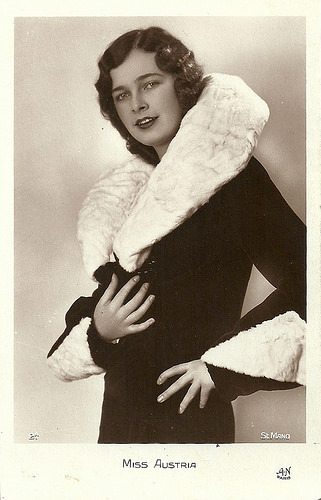
French postcard by A.N., Paris, no. 2A. Photo: St. Mano. Caption: Miss Austria.
The Austrian representative at the Miss Europe 1931 pageant was Hertha van Haentjens. After the Parisian contest, Van Haentjens got the lead in an Austrian early sound film film, Wiener Zauberklänge/Viennese Magic Tunes (Robert Reich, 1931), opposite Wolf Albach-Retty .
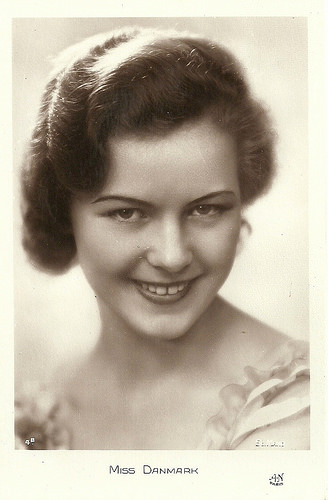
French postcard by A.N., Paris. Photo: St. Mano. Caption: Miss Denmark.
Danish representative for the Miss Europe 1931 pageant was Inga Arvad (1913-1973). Arvad was the 1931 beauty queen selected by the Danish newspaper Berlingske Tidende. After the pageant she appeared in two Danish films, the little known Storm Varsel and Flugten fra millionerne/Flight from the Millions (Pál Fejös, 1934). She started to work as a journalist and interviewed Adolf Hitler and was his companion at the 1936 Summer Olympics.
In 1939 Inga Arvad moved to the U.S. and had a romantic relationship with John F. Kennedy during 1941 and 1942. This led to suspicions that she was a Nazi spy, but investigations uncovered no such evidence. In the U.S., she worked as a motion picture writer for Metro-Goldwyn-Mayer and a Hollywood gossip columnist. Arvad's first husband was Kamal Abdel Nabi, whom she married in 1931, when she was 17. Her second husband was Hungarian film director Pál Fejös or Paul Fejos. From 1945 until her death she was the wife of wealthy cowboy actor and military officer Tim McCoy.
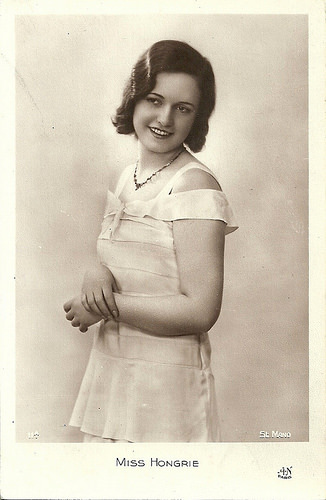
French postcard by A.N., Paris, no. 11A. Photo: St. Mano. Caption: Miss Hongrie.
Hungary's representative at the Miss Europe 1931 pageant was Maria Tasnady-Fekete (1911-2001), who later became well known as singer, stage and film actress Maria von Tasnady. After the Miss Europe pageant, Maria moved to Weimar Germany, where she made her film debut in 1932 in Durchlaucht amusiert sich (Conrad Wiene, 1932) with Georg Alexander . She made several German films such as Douglas Sirk's Schlussakkord (1936) in which she had the lead. Later, she also worked in her native Hungary and in Italy where she appeared in the patriotic war film Bengasi (Augusto Genina, 1942) with Fosco Giachetti .
All in all, Maria von Tasnady appeared in 25 films during her career. Following the Second World War, she was employed by Radio Free Europe, and played in three more three films, e.g. as Caruso's mother in Enrico Caruso - Leggenda di una voce/The Young Caruso (Giacomo Gentilomo, 1951). She retired in the late 1950s. Maria von Tasnady was married to the film producer Bruno Duday.

French postcard by A.N., Paris, no. 3B. Photo: St. Mano. Caption: Miss Belgique.
Belgium's representative at the Miss Europe 1931 pageant was Annette 'Netta' Duchateau (1910-1994). She became Miss Namur and subsequently Miss Belgium in 1930, joined in the Miss Europe contest in Paris and became Miss Universe in Galveston in 1931 at the age of 20. She was the first Miss Belgium to obtain that title.
In 1932 Annette Duchateau started a modest career in cinema, playing a small part in her only film, Grains de beauté (Pierre Caron, 1932) with Roger Tréville . After that she became stage actress. During the war she played in Ces dames aux chapeaux verts in Paris. After that she acted in the Brussels theatres, e.g. as Roxane in Cyrano de Bergerac. At the end of her career she emigrated to France, then Monaco, where she died at the age of 83. Supposedly she inspired Sterne Stevens for his design for Miss Belga cigarettes.
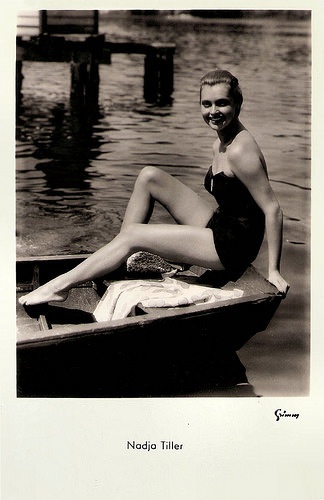
French postcard by Editions P.I., Paris, no. FK 3814. Photo: Arthur Grimm / Ufa.
Austrian actress Nadja Tiller (1929) started out as a model. She won the Miss Austria contest twice, in 1949 and 1951, which turned out to be her ticket into filmmaking. In 1949, she acted opposite O.W. Fischer in Märchen vom Glück (Arthur de Glahs, 1949). Many roles as a vamp in German and Austrian films followed. In 1954 she worked with director Rolf Thiele in the successful Sie. Until 1970 they would make ten more movies together, including Die Barrings (1955), and Lulu (1962), with Mario Adorf .
Nadja Tiller’s international breakthrough role was that of the high class prostitute Rosemarie Nitribitt in Das Mädchen Rosemarie (Rolf Thiele, 1958). The film, based on a scandal, confirmed the assumption of post-war, American audiences that European actresses were somehow more sensuous and erotic than their Hollywood counterparts. With international productions like The Rough and the Smooth (Robert Siodmak, 1959), Du Rififi chez les femmes (Alex Joffé, 1959), and Anima nera (Roberto Rossellini, 1962), Tiller stayed a favourite of the art house public. She would act in more than 70 films.
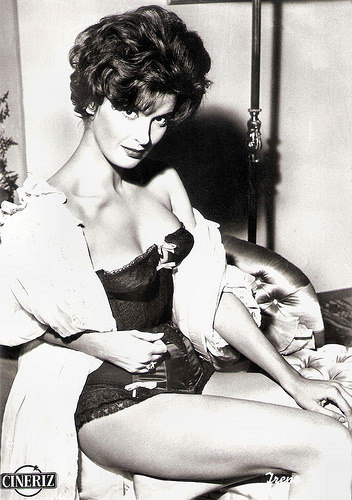
Italian postcard by Bromofoto, Milano (Milan), no. 1656. Photo: Cineriz.
Sexy French actress and model Irène Tunc (1935-1972) was chosen Miss Côte d'Azur 1953 in the beach town of Juan-les-Pins. At the time, she was already working as a mannequin, modeling for local papers and posing in beachwear for holiday postcards. The next year, she was crowned Miss France in 1954 at the age of 19. One of her first film roles was opposite Franco Fabrizi and Gabriele Ferzetti in the Italian comedy-drama Camilla (Luciano Emmer, 1954). In Italy, she also appeared with Alberto Sordi in Bravissimo (Luigi Filippo D'Amico, 1955). Back in France, she continued to model in Paris and studied acting at the school of Françoise Rosay . After a few small parts in French films, she returned to Italy for better roles. She played the lead role in the melodrama La sposa/The wife (Edmondo Lozzi, 1958), and a supporting part in the crime-comedy Noi siamo due evasi (Giorgio Simonelli, 1959).
Irène Tunc found more rewarding roles in the French cinema with the raise of the Nouvelle Vague. She had a big supporting part in the classic Léon Morin, prêtre/Léon Morin, Priest/The Sin (Jean-Pierre Melville, 1961), starring Jean-Paul Belmondo . Also memorable is Vivre pour vivre/Live for Life (Claude Lelouch, 1967), starring Yves Montand . Irène Tunc died in a car crash in 1972 in Versailles She was only 36.
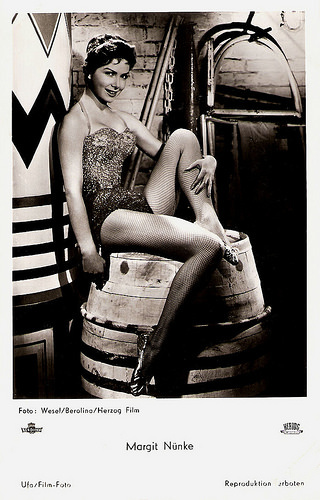
German postcard by Ufa, Berlin-Tempelhof, no. FK 3615. Photo: Wesel / Berolina / Herzog Film. Publicity still for Das haut hin/The skin-out (Géza von Cziffra, 1957).
Gorgeous German actress Margit Nünke (1930) became Miss Germany in 1955 after previously being Miss North Rhine-Westphalia. The following year, 1956, she won the Miss Europe pageant in Stockholm before 12 other candidates and in front of 5,000 spectators. Finally, she reached the 4th place at the Miss Universe contest in Long Beach, USA, in 1958. From 1957 on she appeared in feature films and TV movies. In Italy, she acted opposite Rik Battaglia in I fidanzati della morte/The betrothed of death (Romolo Marcellini, 1957). In the German musical comedy Das haut hin/The skin-out (Géza von Cziffra, 1957) she appeared opposite the popular Peter Alexander . In the Austrian film Geliebte Bestie/Arena of Fear (Arthur Maria Rabenalt, 1959), she put her dancing skills to the test.
In the next decade, Margit Nünke continued to appear in German lighter-than-light entertainment films with such film partners as Walter Giller and Toni Sailer . Titles include the Conny Froboess comedy Meine Nichte tut das nicht/My Niece Doesn't Do That (Franz Josef Gottlieb, 1960), and Liebesgrüße aus Tirol/With Love from Tyrol (Franz Antel, 1964) with Peter Weck . As a singer, she recorded several singles, including the duet Jede Woche, die hat 7 Tage (Every week has 7 days) with her husband Peter Garden . Together, they performed in his TV-series Garden-Party (1969-1970).
Sources: Filmpolski.pl, Wikipedia and .

British postcard by Rotary Photo, London, no. 5.76. 6. Caption: The Daily Sketch girl. Adopted by Miss Norma Talmadge.
Margaret Leahy (1902–1967) won a beauty contest of the British Daily Sketch. In 1922, a starring role in a major Hollywood film was offered by the newspaper in a grand and widely publicised film star competition. The competition was to find a British actress to play second lead in Norma Talmadge's forthcoming Hollywood production Within The Law. The contestants reputably numbered nearly 80,000 and the competition resulted in three girls thought suitable: Katherine Campbell, the French Agnès Souret and Leahy. Prior to depart to Hollywood, Leahy toured several major cities in Europe and was greeted with hundreds of cheering fans and photographers as the new film star that was about to be born.
In Hollywood, Margaret Leahy began working with director Frank Lloyd who was going to make her a 'star.' Although it was said by her publicity that the young beauty queen had acted in English and French films, this proved to be highly untrue. Lloyd had her dismissed from Within the Law (1923). He claimed that Leahy could do nothing that an actress was supposed to be able to do. Following this, producer Joseph Schenck believed it did not take much to be a comedian, and handed Margaret over to his brother-in-law Buster Keaton to appear in his next comedy, the silent feature Three Ages (Edward F. Cline, Buster Keaton, 1923). Leahy's only film did absolutely nothing to improve her already crumbling film career. After the film finished shooting, there were no attempts to put her in any other films as she was labeled as being untalented and incapable of learning how to act. She went so far as to sue Joseph Schenck for $50,000 for breach of contract and injured feelings. Leahy chose to remain in California and get married, instead of returning to England.

German postcard by Ross Verlag, no. 3324/3, 1928-1929. Photo: Alex Binder, Berlin.
Yugoslav film actress and beauty queen Ita Rina (1907-1979) was one of the major film stars in Germany and Czechoslovakia in the late 1920s and early 1930s. In October 1926, Slavic People magazine organised a beauty pageant for a Miss to represent Yugoslavia at the Miss Europe contest. The attractive nineteen-year-old Rina secretly entered the beauty contest, not telling anyone at home. She was crowned Miss Slovenia and should travel to the final event for Miss Yugoslavia in Zagreb. Then her mother forbade her go to Zagreb. However, she was noticed by Adolf Müller, the owner of Balkan Palace cinema in Zagreb. He sent her photographs to German film producer Peter Ostermayer, who invited her to come to Germany. As her mother did not want to let her go to Berlin, Rina ran away from home and arrived in Berlin in 1927. After her first audition, she had classes in acting, diction, dancing, driving and riding.
Ita Rina made her film debut in the leading role in Was die Kinder ihren Eltern verschweigen/What Do Children Hide from Their Parents (Franz Osten, 1927) with Mary Johnson. The critics noticed her in Das letzte Souper/The Last Supper (Mario Bonnard, 1928). Her big breakthrough came the following year in Erotikon/Seduction (1929), directed by Gustav Machatý. The film was a great success but also upset some moral and Christian organizations. In 1931, Ita Rina earned 15,000 marks per month and was an idol to teenagers as well as modern emancipated women. The same year, Rina was given an offer from Hollywood, but her husband forced her to choose between her career and their marriage; Rina chose to stay with him. Although she had announced her retirement from the cinema, she acted until the outbreak of the World War II.

French postcard by A.N., Paris. Caption: France - Germaine Laborde
Germaine Laborde was Miss France 1928, after being elected Miss Gascogne in 1927. She joined the 1929 Miss Europe contest but didn't win; she became third after Hungary and Poland. On her return to France, Mlle. Laborde played with Mistinguett at the Casino de Paris in the revue, Paris-Miss. Laborde also acted in the film Chacun sa chance by René Pujol and Hanns Steinhoff, starring Renée Heribel and Jean Gabin . Her career didn't last very long and she became a nanny.

French postcard by A.N., Paris, no. 14. Caption: Miss Polonia.
Polish model and actress Zofia Batycka (1907-1989) studied at the Warsaw School of Economics. She supposedly had an affair with tenor Jan Kiepura in 1928 but they never married. As a student Zofia made her debut in the cinema. From 1929 on she played in Polish films, first in the silent Sfinks production Grzeszna milosc (Zbigniew Gniazdowski, Mieczyslaw Krawicz, 1929), partly filmed at the Tatra Mountains. It was followed by the silent films Szlakiem hanby/Export in Blond (Mieczyslaw Krawicz, Alfred Niemirski, 1929) and Dusze w niewoli/Souls in Bondage (Leon Trystan, 1930). Moralnosc pani Dulskiej (Boleslaw Newolin, 1930) was probably her first sound film. It was followed by the short sound film Kobieta, która sie smieje (Ryszard Ordynski, 1931) which was shot at the Paris Paramount sound studios, and the sound feature Dziesieciu z Pawiaka/10 Condemned (Ryszard Ordynski, 1931).
When Zofia Batycka won the title of Miss Polonia 1930, she became extremely popular. She joined the Miss Europe 1930 contest in Paris. Winner that year was Miss Greece Aliki Diplarakou. Batycka went on to win the title of Miss Paramount in 1931 and went to Hollywood in hope of a film career there. While away, Miss Poland 1931 couldn't go through as Batycka had forgotten to hand over the temporary crown. In 1932, Batycka signed with the American label International Artists. It proved to be completely unsuccessful - in fact she didn't do any movies in Hollywood. In 1934 she returned to Poland and for a time there she worked as a theatre actress. Soon she gave up acting and married. After the war she moved to the United States and settled in Los Angeles. After her husband's death and that of her mother, she maintained herself by teaching foreign languages (she mastered four languages), and then worked in a gallery. She died in obscurity in 1989.

French postcard by A.N., Paris, no. 1c. Photo: St. Mano. Caption: Miss Europa - France.
Jeanne Juilla was elected Miss Garonne in 1930 and Miss France in 1931, so she joined the Miss Europe 1931 pageant ... and won. Juilla worked as fashion model, and was photographed by Dora Kalmus for L'Officiel de la Mode in 1933. She also played supporting acts in some films: Sa meilleure cliente (Pierre Colombier, 1932) starring Elvire Popesco , La prison de Sainte Clothaire (Pierre-Jean Ducis, 1933) in which Juilla played a bar owner, Une femme chipée (Pierre Colombier, 1934), and Samson (Maurice Tourneur, 1936) with Harry Baur .

French postcard by A.N., Paris, no. 2A. Photo: St. Mano. Caption: Miss Austria.
The Austrian representative at the Miss Europe 1931 pageant was Hertha van Haentjens. After the Parisian contest, Van Haentjens got the lead in an Austrian early sound film film, Wiener Zauberklänge/Viennese Magic Tunes (Robert Reich, 1931), opposite Wolf Albach-Retty .

French postcard by A.N., Paris. Photo: St. Mano. Caption: Miss Denmark.
Danish representative for the Miss Europe 1931 pageant was Inga Arvad (1913-1973). Arvad was the 1931 beauty queen selected by the Danish newspaper Berlingske Tidende. After the pageant she appeared in two Danish films, the little known Storm Varsel and Flugten fra millionerne/Flight from the Millions (Pál Fejös, 1934). She started to work as a journalist and interviewed Adolf Hitler and was his companion at the 1936 Summer Olympics.
In 1939 Inga Arvad moved to the U.S. and had a romantic relationship with John F. Kennedy during 1941 and 1942. This led to suspicions that she was a Nazi spy, but investigations uncovered no such evidence. In the U.S., she worked as a motion picture writer for Metro-Goldwyn-Mayer and a Hollywood gossip columnist. Arvad's first husband was Kamal Abdel Nabi, whom she married in 1931, when she was 17. Her second husband was Hungarian film director Pál Fejös or Paul Fejos. From 1945 until her death she was the wife of wealthy cowboy actor and military officer Tim McCoy.

French postcard by A.N., Paris, no. 11A. Photo: St. Mano. Caption: Miss Hongrie.
Hungary's representative at the Miss Europe 1931 pageant was Maria Tasnady-Fekete (1911-2001), who later became well known as singer, stage and film actress Maria von Tasnady. After the Miss Europe pageant, Maria moved to Weimar Germany, where she made her film debut in 1932 in Durchlaucht amusiert sich (Conrad Wiene, 1932) with Georg Alexander . She made several German films such as Douglas Sirk's Schlussakkord (1936) in which she had the lead. Later, she also worked in her native Hungary and in Italy where she appeared in the patriotic war film Bengasi (Augusto Genina, 1942) with Fosco Giachetti .
All in all, Maria von Tasnady appeared in 25 films during her career. Following the Second World War, she was employed by Radio Free Europe, and played in three more three films, e.g. as Caruso's mother in Enrico Caruso - Leggenda di una voce/The Young Caruso (Giacomo Gentilomo, 1951). She retired in the late 1950s. Maria von Tasnady was married to the film producer Bruno Duday.

French postcard by A.N., Paris, no. 3B. Photo: St. Mano. Caption: Miss Belgique.
Belgium's representative at the Miss Europe 1931 pageant was Annette 'Netta' Duchateau (1910-1994). She became Miss Namur and subsequently Miss Belgium in 1930, joined in the Miss Europe contest in Paris and became Miss Universe in Galveston in 1931 at the age of 20. She was the first Miss Belgium to obtain that title.
In 1932 Annette Duchateau started a modest career in cinema, playing a small part in her only film, Grains de beauté (Pierre Caron, 1932) with Roger Tréville . After that she became stage actress. During the war she played in Ces dames aux chapeaux verts in Paris. After that she acted in the Brussels theatres, e.g. as Roxane in Cyrano de Bergerac. At the end of her career she emigrated to France, then Monaco, where she died at the age of 83. Supposedly she inspired Sterne Stevens for his design for Miss Belga cigarettes.

French postcard by Editions P.I., Paris, no. FK 3814. Photo: Arthur Grimm / Ufa.
Austrian actress Nadja Tiller (1929) started out as a model. She won the Miss Austria contest twice, in 1949 and 1951, which turned out to be her ticket into filmmaking. In 1949, she acted opposite O.W. Fischer in Märchen vom Glück (Arthur de Glahs, 1949). Many roles as a vamp in German and Austrian films followed. In 1954 she worked with director Rolf Thiele in the successful Sie. Until 1970 they would make ten more movies together, including Die Barrings (1955), and Lulu (1962), with Mario Adorf .
Nadja Tiller’s international breakthrough role was that of the high class prostitute Rosemarie Nitribitt in Das Mädchen Rosemarie (Rolf Thiele, 1958). The film, based on a scandal, confirmed the assumption of post-war, American audiences that European actresses were somehow more sensuous and erotic than their Hollywood counterparts. With international productions like The Rough and the Smooth (Robert Siodmak, 1959), Du Rififi chez les femmes (Alex Joffé, 1959), and Anima nera (Roberto Rossellini, 1962), Tiller stayed a favourite of the art house public. She would act in more than 70 films.

Italian postcard by Bromofoto, Milano (Milan), no. 1656. Photo: Cineriz.
Sexy French actress and model Irène Tunc (1935-1972) was chosen Miss Côte d'Azur 1953 in the beach town of Juan-les-Pins. At the time, she was already working as a mannequin, modeling for local papers and posing in beachwear for holiday postcards. The next year, she was crowned Miss France in 1954 at the age of 19. One of her first film roles was opposite Franco Fabrizi and Gabriele Ferzetti in the Italian comedy-drama Camilla (Luciano Emmer, 1954). In Italy, she also appeared with Alberto Sordi in Bravissimo (Luigi Filippo D'Amico, 1955). Back in France, she continued to model in Paris and studied acting at the school of Françoise Rosay . After a few small parts in French films, she returned to Italy for better roles. She played the lead role in the melodrama La sposa/The wife (Edmondo Lozzi, 1958), and a supporting part in the crime-comedy Noi siamo due evasi (Giorgio Simonelli, 1959).
Irène Tunc found more rewarding roles in the French cinema with the raise of the Nouvelle Vague. She had a big supporting part in the classic Léon Morin, prêtre/Léon Morin, Priest/The Sin (Jean-Pierre Melville, 1961), starring Jean-Paul Belmondo . Also memorable is Vivre pour vivre/Live for Life (Claude Lelouch, 1967), starring Yves Montand . Irène Tunc died in a car crash in 1972 in Versailles She was only 36.

German postcard by Ufa, Berlin-Tempelhof, no. FK 3615. Photo: Wesel / Berolina / Herzog Film. Publicity still for Das haut hin/The skin-out (Géza von Cziffra, 1957).
Gorgeous German actress Margit Nünke (1930) became Miss Germany in 1955 after previously being Miss North Rhine-Westphalia. The following year, 1956, she won the Miss Europe pageant in Stockholm before 12 other candidates and in front of 5,000 spectators. Finally, she reached the 4th place at the Miss Universe contest in Long Beach, USA, in 1958. From 1957 on she appeared in feature films and TV movies. In Italy, she acted opposite Rik Battaglia in I fidanzati della morte/The betrothed of death (Romolo Marcellini, 1957). In the German musical comedy Das haut hin/The skin-out (Géza von Cziffra, 1957) she appeared opposite the popular Peter Alexander . In the Austrian film Geliebte Bestie/Arena of Fear (Arthur Maria Rabenalt, 1959), she put her dancing skills to the test.
In the next decade, Margit Nünke continued to appear in German lighter-than-light entertainment films with such film partners as Walter Giller and Toni Sailer . Titles include the Conny Froboess comedy Meine Nichte tut das nicht/My Niece Doesn't Do That (Franz Josef Gottlieb, 1960), and Liebesgrüße aus Tirol/With Love from Tyrol (Franz Antel, 1964) with Peter Weck . As a singer, she recorded several singles, including the duet Jede Woche, die hat 7 Tage (Every week has 7 days) with her husband Peter Garden . Together, they performed in his TV-series Garden-Party (1969-1970).
Sources: Filmpolski.pl, Wikipedia and .
Published on October 13, 2016 22:00
October 12, 2016
Carsta Löck
German actress Carsta Löck (1902–1993) made over 100 films in Germany, Austria and Sweden, from 1933 to 1983. During the 1930s, she was usually cast in comedies and propaganda films as plain or naive provincial girls, as army brides, maids or jovial tomboys. After the war, Löck segued into character parts as wives, mothers and grandmothers. She is lovingly remembered as storyteller Krösa-Maja in the wonderful Astrid Lindgren film adaptation Emil i Lönneberga/Emil in Lonneberga (1971).
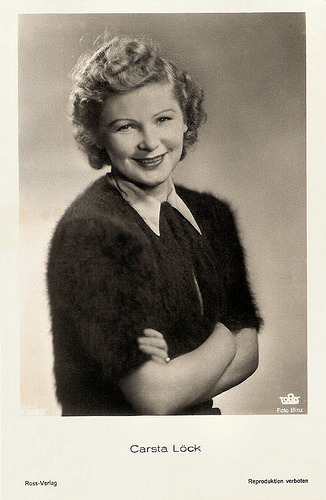
German postcard by Ross Verlag, no. A 3399/1, 1941-1944. Photo: Tobis / Binz.
The National Socialist Spirit
Carsta Betty Löck was born in 1902 in Deezbüll, Schleswig-Holstein in the German Empire. She was the daughter of a rich merchant and she grew up in Kiel. During her school time, she cherished the wish to become an actress and she took her first acting lessons. Her parents requested that she chose a middle-class job and for years she worked as a magazine illustrator. At the same time she attended drama training and when she was 28, she choose for the theatre and left her parents.
In Berlin, she made her stage debut as Rosi in Hermann Sudermann’s Die Schmetterlingsschlacht (The butterfly battle) in 1930. In the same year, she was engaged for the touring company of the Deutsche Volksbühne. She performed at various stages in Berlin, such as the Theater am Nollendorfplatz, the Lessing Theater, the Renaissance Theatre and the Schlossparktheater.
Director Carl Froelich spotted her for the cinema and the 31-years old actress made her film debut in Reifende Jugend/Ripening Youth (Carl Froelich, 1933). She then played a village maid in Wenn am Sonntagabend die Dorfmusik spielt/When the Village Band Plays on a Sunday Evening (Charles Klein, 1933), and had a small part in Flüchtlinge/Refugees (Gustav Ucicky, 1933), starring Hans Albers and Käthe von Nagy . Flüchtlinge was written by Gerhard Menzel and was based on his own novel depicting ethnic Germans, known as Volga Germans, persecuted by the Bolsheviks on the Sino-Russian border in the Soviet province of Manchuria in 1928. It was the first film to win the German state prize, and Joseph Goebbels praised it as among those films that, while they did not explicitly cite National Socialist principles, nevertheless embodied its spirit. The refugees are rescued by a heroic German leader much like the Führer; the symbolism is obviously intended to emulate Adolf Hitler.
In the following years, Löck played supporting parts in several comedies, such as Krach um Jolanthe/Trouble with Jolanthe (Carl Froelich, 1934), Onkel Bräsig/Uncle Bräsig (Erich Waschneck, 1936) starring Otto Wernicke, and Autobus S (Heinz Hille, 1937), starring Hermann Speelmans. She often got the part of the simple country girl and with her humour and timing she became a darling of many German film fans.
She then appeared with Ingrid Bergman and Sabine Peters in the drama Die vier Gesellen/The Four Companions (Carl Froelich, 1938). The film was intended as a star vehicle to launch Bergman's career in Germany. Löck played the female lead in the historical war film Kadetten/Cadets (Karl Ritter, 1939), starring Mathias Wieman. The film is set in 1760, against the backdrop of the Austro-Russian Raid on Berlin during the Seven Years' War. It depicts a group of Prussian cadets holding off superior Russian forces. Because of its anti-Russian theme the film was pulled from release in 1939 following the Nazi-Soviet Pact. It was put on general release in December 1941, once Germany and the Soviets were at war. The film is loosely connected to the Prussian film cycle of historical epics.

German postcard by Film-Foto-Verlag, no. A 3531/1, 1941-1944. Photo: Tobis / Star-Foto-Atelier.
Issues of Collective Guilt and Future Rebuilding
During the Second World War, Carsta Löck appeared in supporting parts in lightweight dramas like Mädchen im Vorzimmer/The Girl at the Reception (Gerhard Lamprecht, 1940), featuring Magda Schneider , and in propaganda films like Über alles in der Welt/Above All Else in the World (Karl Ritter, 1941), starring Paul Hartmann .
After the war, her career is unbroken and she played a supporting part in the Rubble film Zwischen gestern und morgen/Between Yesterday and Tomorrow (Harald Braun, 1947) starring Hildegard Knef , Winnie Markus and Sybille Schmitz . In Post-war Germany a group of former guests return to a luxurious Munich hotel where they are haunted by memories of their past interaction with Nelly Dreifuss, a Jewish woman who had died during the Nazi era. As with many other German Rubble films, it examines issues of collective guilt and future rebuilding.
She also appeared in the West-German comedy Film ohne Titel/Film Without a Title (Rudolf Jugert, 1948) with Hans Söhnker and Hildegard Knef . For the DEFA, she appeared in the drama Die Buntkarierten/Girls in Gingham (Kurt Maetzig, 1949) with Camilla Spira. Her resolute appearance in easily remembered support roles helped her to great popularity in the post-war film.
During the 1950s, she continued to appear in supporting parts such as in the comedy Wochenend im Paradies/Weekend in Paradise (Kurt Hoffmann, 1952) starring Paul Dahlke , and the musical comedy Käpt'n Bay-Bay/Captain Bay-Bay (Helmut Käutner, 1953), featuring Hans Albers . Her roles in this period were maids, wives, mothers, housekeepers, secretaries and neighbours. The most notable film of this period was the two-part Thomas Mann adaptation Buddenbrooks (Alfred Weidenmann, 1959).
Her film career drew to a close in the 1960s. Löck returned to the cinema as Krösa-Maja in the Swedish family film Emil i Lönneberga/Emil in Lonneberga (Olle Hellbom, 1971), based on the books by Astrid Lindgren. As Krösa-Maja she told horror stories to the children with goose pimples guarantee. She also appeared in the two sequels, Nya hyss av Emil i Lönneberga/New Mischief by Emil (Olle Hellbom, 1972), and Emil och griseknoen/Emil and the Piglet (Olle Hellbom, 1973). The role made her very popular among children.
Her final film was the German comedy Der Schnüffler/Non Stop Trouble with Spies (Ottokar Rünze, 1983) with Dieter Hallervorden. After that she retired. In 1989 she received the Filmband im Gold, an award for many years of outstanding achievements in the German cinema. Carsta Löck died in Berlin in 1993. She was 90. Since 1963, she was a widow.

German postcard by Ross Verlag, no. A 3246/1, 1941-1944. Photo: Tobis / Binz.
Sources: Stephanie D’heil (Steffi-Line – German), Thomas Staedeli (Cyranos), FilmZeit.de (German), Wikipedia (German and English) and .

German postcard by Ross Verlag, no. A 3399/1, 1941-1944. Photo: Tobis / Binz.
The National Socialist Spirit
Carsta Betty Löck was born in 1902 in Deezbüll, Schleswig-Holstein in the German Empire. She was the daughter of a rich merchant and she grew up in Kiel. During her school time, she cherished the wish to become an actress and she took her first acting lessons. Her parents requested that she chose a middle-class job and for years she worked as a magazine illustrator. At the same time she attended drama training and when she was 28, she choose for the theatre and left her parents.
In Berlin, she made her stage debut as Rosi in Hermann Sudermann’s Die Schmetterlingsschlacht (The butterfly battle) in 1930. In the same year, she was engaged for the touring company of the Deutsche Volksbühne. She performed at various stages in Berlin, such as the Theater am Nollendorfplatz, the Lessing Theater, the Renaissance Theatre and the Schlossparktheater.
Director Carl Froelich spotted her for the cinema and the 31-years old actress made her film debut in Reifende Jugend/Ripening Youth (Carl Froelich, 1933). She then played a village maid in Wenn am Sonntagabend die Dorfmusik spielt/When the Village Band Plays on a Sunday Evening (Charles Klein, 1933), and had a small part in Flüchtlinge/Refugees (Gustav Ucicky, 1933), starring Hans Albers and Käthe von Nagy . Flüchtlinge was written by Gerhard Menzel and was based on his own novel depicting ethnic Germans, known as Volga Germans, persecuted by the Bolsheviks on the Sino-Russian border in the Soviet province of Manchuria in 1928. It was the first film to win the German state prize, and Joseph Goebbels praised it as among those films that, while they did not explicitly cite National Socialist principles, nevertheless embodied its spirit. The refugees are rescued by a heroic German leader much like the Führer; the symbolism is obviously intended to emulate Adolf Hitler.
In the following years, Löck played supporting parts in several comedies, such as Krach um Jolanthe/Trouble with Jolanthe (Carl Froelich, 1934), Onkel Bräsig/Uncle Bräsig (Erich Waschneck, 1936) starring Otto Wernicke, and Autobus S (Heinz Hille, 1937), starring Hermann Speelmans. She often got the part of the simple country girl and with her humour and timing she became a darling of many German film fans.
She then appeared with Ingrid Bergman and Sabine Peters in the drama Die vier Gesellen/The Four Companions (Carl Froelich, 1938). The film was intended as a star vehicle to launch Bergman's career in Germany. Löck played the female lead in the historical war film Kadetten/Cadets (Karl Ritter, 1939), starring Mathias Wieman. The film is set in 1760, against the backdrop of the Austro-Russian Raid on Berlin during the Seven Years' War. It depicts a group of Prussian cadets holding off superior Russian forces. Because of its anti-Russian theme the film was pulled from release in 1939 following the Nazi-Soviet Pact. It was put on general release in December 1941, once Germany and the Soviets were at war. The film is loosely connected to the Prussian film cycle of historical epics.

German postcard by Film-Foto-Verlag, no. A 3531/1, 1941-1944. Photo: Tobis / Star-Foto-Atelier.
Issues of Collective Guilt and Future Rebuilding
During the Second World War, Carsta Löck appeared in supporting parts in lightweight dramas like Mädchen im Vorzimmer/The Girl at the Reception (Gerhard Lamprecht, 1940), featuring Magda Schneider , and in propaganda films like Über alles in der Welt/Above All Else in the World (Karl Ritter, 1941), starring Paul Hartmann .
After the war, her career is unbroken and she played a supporting part in the Rubble film Zwischen gestern und morgen/Between Yesterday and Tomorrow (Harald Braun, 1947) starring Hildegard Knef , Winnie Markus and Sybille Schmitz . In Post-war Germany a group of former guests return to a luxurious Munich hotel where they are haunted by memories of their past interaction with Nelly Dreifuss, a Jewish woman who had died during the Nazi era. As with many other German Rubble films, it examines issues of collective guilt and future rebuilding.
She also appeared in the West-German comedy Film ohne Titel/Film Without a Title (Rudolf Jugert, 1948) with Hans Söhnker and Hildegard Knef . For the DEFA, she appeared in the drama Die Buntkarierten/Girls in Gingham (Kurt Maetzig, 1949) with Camilla Spira. Her resolute appearance in easily remembered support roles helped her to great popularity in the post-war film.
During the 1950s, she continued to appear in supporting parts such as in the comedy Wochenend im Paradies/Weekend in Paradise (Kurt Hoffmann, 1952) starring Paul Dahlke , and the musical comedy Käpt'n Bay-Bay/Captain Bay-Bay (Helmut Käutner, 1953), featuring Hans Albers . Her roles in this period were maids, wives, mothers, housekeepers, secretaries and neighbours. The most notable film of this period was the two-part Thomas Mann adaptation Buddenbrooks (Alfred Weidenmann, 1959).
Her film career drew to a close in the 1960s. Löck returned to the cinema as Krösa-Maja in the Swedish family film Emil i Lönneberga/Emil in Lonneberga (Olle Hellbom, 1971), based on the books by Astrid Lindgren. As Krösa-Maja she told horror stories to the children with goose pimples guarantee. She also appeared in the two sequels, Nya hyss av Emil i Lönneberga/New Mischief by Emil (Olle Hellbom, 1972), and Emil och griseknoen/Emil and the Piglet (Olle Hellbom, 1973). The role made her very popular among children.
Her final film was the German comedy Der Schnüffler/Non Stop Trouble with Spies (Ottokar Rünze, 1983) with Dieter Hallervorden. After that she retired. In 1989 she received the Filmband im Gold, an award for many years of outstanding achievements in the German cinema. Carsta Löck died in Berlin in 1993. She was 90. Since 1963, she was a widow.

German postcard by Ross Verlag, no. A 3246/1, 1941-1944. Photo: Tobis / Binz.
Sources: Stephanie D’heil (Steffi-Line – German), Thomas Staedeli (Cyranos), FilmZeit.de (German), Wikipedia (German and English) and .
Published on October 12, 2016 22:00
October 11, 2016
Come le foglie (1917)
Italian diva Maria Jacobini was the star of the silent comedy-drama Come le foglie/Like the Leaves (Gennaro Righelli, 1917). The film was based on a stage play by Giuseppe Giacosa, which was performed for the first time at the Teatro Manzoni in Milan in 1900 by the company Tina Di Lorenzo. The cast of the film version also included Alberto Collo, Ignazio Luppi, Ida Carloni Talli, Diana d'Amore, Floriana and Guido Guiducci.
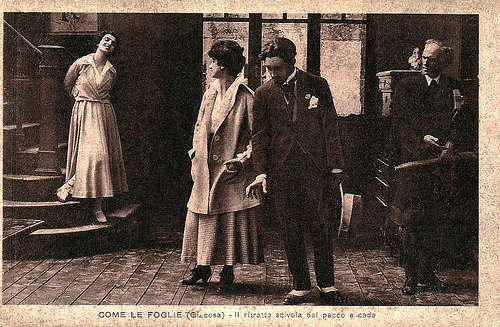
Italian postcard. Photo: Tiber Film, Roma. Publicity still for Come le foglie/Like the Leaves (Gennaro Righelli, 1917). Left Maria Jacobini . Translation caption : The portrait slipped from the package and fell to the ground.
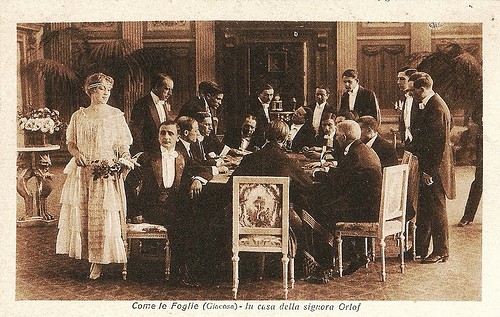
Italian postcard. Photo: Tiber Film, Roma. Alberto Collo as Tommy in Come le foglie/Like the Leaves (Gennaro Righelli, 1917). Translation caption: In the house of Ms. Orlof.
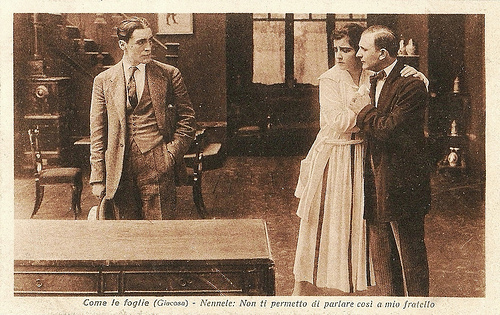
Italian postcard. Photo: Tiber Film, Roma. Guido Guiducci (Massimo), Maria Jacobini as Nennele and Alberto Collo as her brother Tommy in Come le foglie/Like the Leaves (Gennaro Righelli, 1917). Translation caption: I won't allow you to speak about my brother in this way.
A life of spendthrifts
Maria Jacobini (1892-1944) could play it all: the island of serenity, the vivacious lady, the femme fatale, the comedienne, the hysterical victim, and the suffering mother or wife. In Come le foglie/Like the Leaves (Gennaro Righelli, 1917), she plays a daughter, Nennele Rosati.
After a life of spendthrifts, the Rosati family is ruined. Father Giovanni ( Ignazio Lupi ) accepts work from his cousin Massimo (Guido Guiducci).
Hitherto neglected as too serious and workaholic, Massimo becomes the head of the family and takes care of the son and daughter of Giovanni, Tommy ( Alberto Collo ) and Nennele (Jacobini), and their stepmother Giulia (Floriana).
Tommy and Giulia remain weak spirits, but after an attempted suicide, Nennele realizes Massimo's force and unites with him.
Little is known about Italian actor Guido Guiducci, who plays Massimo. Though he made a handful of films before, his career really set off after Come le foglie. Guiducci was often paired with female stars Ileana Leonidoff , Hesperia and Mary Bayma-Riva. Guiducci's last film was Occhi luccenti (1923), a film he directed himself as well.
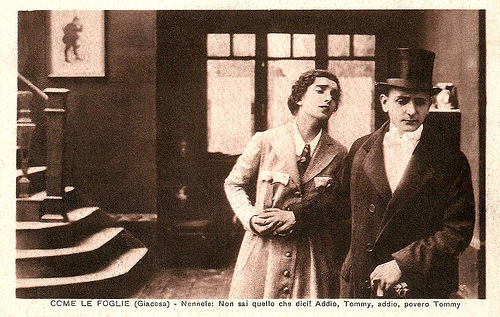
Italian postcard. Photo: Tiber Film, Roma. Publicity still for Come le foglie/Like the Leaves (Gennaro Righelli, 1917). Maria Jacobini (Nennele) and Alberto Collo (Tommy). Translation caption: Nennele: You don't know what you're saying! Farewell, Tommy, farewell, poor Tommy!
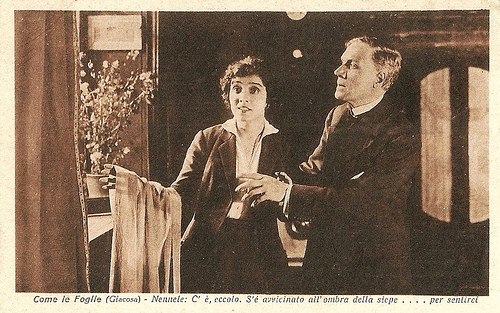
Italian postcard. Photo: Tiber Film, Roma. Maria Jacobini (Nennele) and Ignazio Lupi (her father Giovanni) in Come le foglie/Like the Leaves (Gennaro Righelli, 1917). Translation caption: Nennele: He is here! He has approached in the shadow of the hedge... to hear us.

Italian postcard. Photo: Tiber Film, Roma. Publicity still of Maria Jacobini and Ignazio Lupi in the Italian silent film Come le foglie/Like the leaves (Gennaro Righelli, 1917). The caption translates: Giovanni: And tomorrow I would have been out in the world, shouting like a madman, searching for my little daugher.
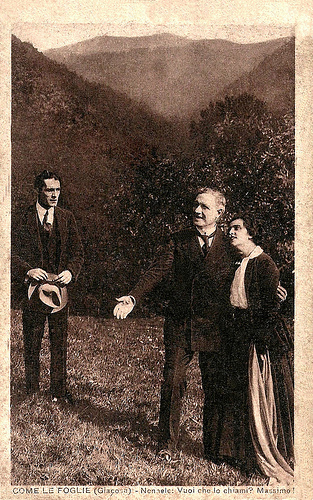
Italian postcard. Photo: Tiber Film. Publicity still for Come le foglie/Like the Leaves (Gennaro Righelli, 1917). Father Giovanni ( Ignazio Lupi ) unites his daughter Nennele ( Maria Jacobini ) with his cousin Massimo (Guido Guiducci). Translation caption: Nennele: Shall I call him? Massimo!
Sources: Vittorio Martinelli (Il Cinema Muto Italiano: 1917), Wikipedia (Italian) and IMDb.

Italian postcard. Photo: Tiber Film, Roma. Publicity still for Come le foglie/Like the Leaves (Gennaro Righelli, 1917). Left Maria Jacobini . Translation caption : The portrait slipped from the package and fell to the ground.

Italian postcard. Photo: Tiber Film, Roma. Alberto Collo as Tommy in Come le foglie/Like the Leaves (Gennaro Righelli, 1917). Translation caption: In the house of Ms. Orlof.

Italian postcard. Photo: Tiber Film, Roma. Guido Guiducci (Massimo), Maria Jacobini as Nennele and Alberto Collo as her brother Tommy in Come le foglie/Like the Leaves (Gennaro Righelli, 1917). Translation caption: I won't allow you to speak about my brother in this way.
A life of spendthrifts
Maria Jacobini (1892-1944) could play it all: the island of serenity, the vivacious lady, the femme fatale, the comedienne, the hysterical victim, and the suffering mother or wife. In Come le foglie/Like the Leaves (Gennaro Righelli, 1917), she plays a daughter, Nennele Rosati.
After a life of spendthrifts, the Rosati family is ruined. Father Giovanni ( Ignazio Lupi ) accepts work from his cousin Massimo (Guido Guiducci).
Hitherto neglected as too serious and workaholic, Massimo becomes the head of the family and takes care of the son and daughter of Giovanni, Tommy ( Alberto Collo ) and Nennele (Jacobini), and their stepmother Giulia (Floriana).
Tommy and Giulia remain weak spirits, but after an attempted suicide, Nennele realizes Massimo's force and unites with him.
Little is known about Italian actor Guido Guiducci, who plays Massimo. Though he made a handful of films before, his career really set off after Come le foglie. Guiducci was often paired with female stars Ileana Leonidoff , Hesperia and Mary Bayma-Riva. Guiducci's last film was Occhi luccenti (1923), a film he directed himself as well.

Italian postcard. Photo: Tiber Film, Roma. Publicity still for Come le foglie/Like the Leaves (Gennaro Righelli, 1917). Maria Jacobini (Nennele) and Alberto Collo (Tommy). Translation caption: Nennele: You don't know what you're saying! Farewell, Tommy, farewell, poor Tommy!

Italian postcard. Photo: Tiber Film, Roma. Maria Jacobini (Nennele) and Ignazio Lupi (her father Giovanni) in Come le foglie/Like the Leaves (Gennaro Righelli, 1917). Translation caption: Nennele: He is here! He has approached in the shadow of the hedge... to hear us.

Italian postcard. Photo: Tiber Film, Roma. Publicity still of Maria Jacobini and Ignazio Lupi in the Italian silent film Come le foglie/Like the leaves (Gennaro Righelli, 1917). The caption translates: Giovanni: And tomorrow I would have been out in the world, shouting like a madman, searching for my little daugher.

Italian postcard. Photo: Tiber Film. Publicity still for Come le foglie/Like the Leaves (Gennaro Righelli, 1917). Father Giovanni ( Ignazio Lupi ) unites his daughter Nennele ( Maria Jacobini ) with his cousin Massimo (Guido Guiducci). Translation caption: Nennele: Shall I call him? Massimo!
Sources: Vittorio Martinelli (Il Cinema Muto Italiano: 1917), Wikipedia (Italian) and IMDb.
Published on October 11, 2016 22:00
October 10, 2016
Manfred Krug
German actor Manfred Krug (1937) was often cast as a socialist hero in DEFA films of the former GDR. He also became known in East-Germany as a jazz singer. In 1977, he returned to West-Germany, where he became a popular TV star.
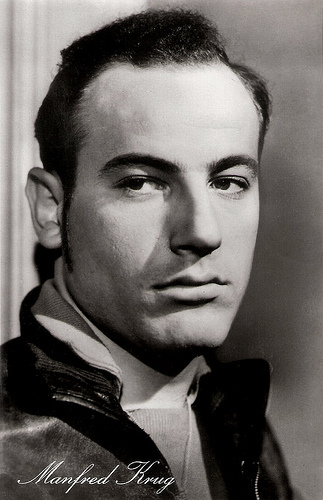
East-German postcard by VEB Progress Filmvertrieb, no. 966, 1959. Retail price: 0,20 DM. Photo: DEFA / Dassdorf. Publicity still for Reportage 57 (János Veiczi, 1959).
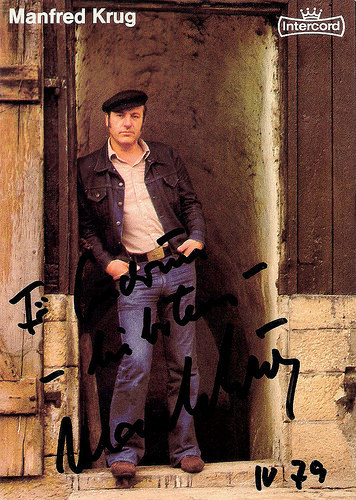
German promotion card by Intercord, Stuttgart, 1979.
Powerful body language and rebellious presence
Manfred Krug was born in 1937 in Duisburg, Germany. His parents were Rudolf and Alma Krug. In 1949, after the divorce of his parents, the 13-years-old Manfred moved with his father from Duisburg to the newly founded German Democratic Republic (GDR). The young Krug trained as a steel smelter in Brandenburg an der Havel. A splash of liquid steel caused a distinctive scar on his forehead.
Krug worked for four years in a steel plant and rolling mill. In the evenings he studied and decided to go to drama school. From 1955 to 1957 he was an apprentice at Bertolt Brecht's Berliner Ensemble. In 1957, Krug made his film debut as a guitarist in Die Schönste/The most beautiful (Ernesto Remani, Walter Beck, 1957).
Filmportal.de : “Because of his strong build, his powerful body language, and his rebellious presence, Krug mainly played roles of villains and young rowdies in the early years of his movie career.” He played a smuggler in the crime film Ware für Katalonien/Goods For Catalonia (Richard Groschopp, 1959), based on a true fraud: a criminal sold the entire stock of optical instruments produced by the Zeiss factory in Jena, East Germany, to the Spanish Army and to customers in Barcelona.
Krug also appeared in the successful war film Fünf Patronenhülsen/Five Cartridges (Frank Beyer, 1960) opposite Erwin Geschonneck and Armin Mueller-Stahl . During the Spanish Civil War, a battalion of the International Brigades is cut off without water or ammunition. Five Cartridges won director Frank Beyer great acclaim, and also for Krug many more film roles followed. He also achieved notability as a jazz singer.
He appeared in the drama Professor Mamlock (Konrad Wolf, 1961) about a Jewish surgeon (Wolfgang Heinz) in Germany of the early 1930s. It was based on the play Professor Mamlock, written by the director's father Friedrich Wolf during 1933, when he was in exile in France.
Krug was often cast as the tough guy with a heart of gold, such as in Auf der Sonnenseite/On the Sunny Side (Ralf Kirsten, 1962). In this musical comedy he starred as a steel smelter and an amateur actor and jazz singer, who is sent to a drama school by his factory's committee. The film's script was largely inspired by Krug's biography: he worked in a steel factory before turning to an acting career. His jazz band and his singing career were also a central theme in the plot.
DEFA historian Dagmar Schittly notes that Auf der Sonnenseite was the most popular East German film of the early 1960s, and Krug and the collective crew were awarded the Heinrich Greif Prize for their work. Krug managed to give the Communist system a human face and credibility. Krug and director Kirsten reunited for the historical adventure Mir nach, Canaillen!/Follow Me, Scoundrels (Ralf Kirsten, 1964).
Two years later Krug starred in Spur der Steine/Trace of Stones (Frank Beyer, 1966). After its release, the film was shown only for a few days, before being shelved due to conflicts with the Socialist Unity Party, the ruling communist party in the GDR. Krug’s portrayal of a rebellious and brash building site brigadier was deemed as too ‘anarchic’ by the censors.
Filmportal.de : “Indeed, the role of the aggressive, yet down-to-earth worker who defies authority and often kicks over the traces has always been one of Krug's main roles.” Only after 23 years was the film shown again, in 1989, when the Berlin Wall fell.
His other DEFA-films include Die Fahne von Kriwoj Rog/The Banner of Krivoi Rog (Kurt Maetzig, 1967) starring Erwin Geschonneck, and the contemporary Eastern road movie Weite Straßen – stille Liebe/ Wide streets, silent love (Herrmann Zschoche, 1969) with Jaecki Schwarz , which made Krug a favourite among East-German teenage filmgoers.
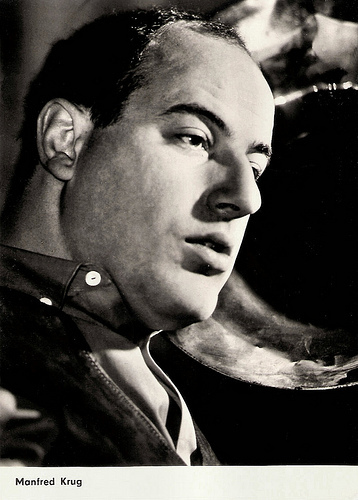
East-German postcard by VEB Progress Filmvertrieb, no. 1.819, 1963. Retail price: 0,20 DM. Photo: Klaus Fischer. Publicity still for Revue um Mitternacht/Midnight Review (Gottfried Kolditz, 1962).
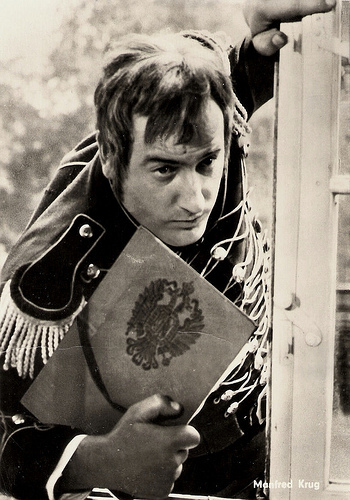
East-German postcard by VEB Progress Filmvertrieb, no. 88/69. Photo: DEFA / Wenzel. Publicity still for Hauptmann Florian von der Mühle/Captain Florian of the Mill (Werner W. Wallroth, 1968).
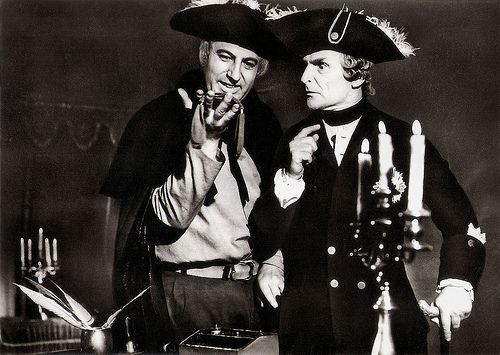
East-German postcard by VEB Bild und Heimat Reichenbach i.V., no. AG 500/12/72. Photo: DEFA / Kroiss. Publicity still for Die gestohlene Schlacht/The stolen battle (Erwin Stranka, 1972) with Herwart Grosse.
Pushed off
In 1976 Manfred Krug participated in protests against the expulsion and stripping of GDR citizenship of singer-songwriter Wolf Biermann. Suddenly the popular Krug, who had won numerous awards in the years before (among them the National award and the Medal for Merit of the GDR), was subjected to sanctions and censorship. The situation escalated when Krug beat down a Stasi informer who had insulted and defamed him publicly.
After six months of partly unemployment, Krug requested to leave the GDR in 1977. As soon as he got the approval he left East-Germany and moved to Schöneberg in West Berlin. Twenty years later, he wrote about these events in his book Abgehauen (1997, Pushed off). This memoir became a bestseller and in was filmed by Frank Beyer in 1998.
After moving back to West Germany, Manfred Krug very soon got new roles. In 1978 he appeared as the adventurous truck driver Franz Meersdonk in the TV series Auf Achse/On the Axis. He continued to play in the series until 1995, one year before the show ended its long run. Krug's various television roles even included a two-year stint on the children's program Sesamstraße (1982-1984), the German version of the American children's program Sesame Street.
He was very popular as an attorney in the Berlin-based comedic attorney TV series Liebling Kreuzberg/Darling Kreuzberg (1986-1998). From 1984 till 2001, he also starred as Hamburg-based commissioner Paul Stoever in the Krimi series Tatort, which would eventually run for a total of 41 instalments.
His later feature films include the comedy Neuner (Werner Masten, 1990), and the political drama Der Blaue/The Blue One (Lienhard Wawrzyn, 1994), which was entered into the 44th Berlin International Film Festival. In 2005, his second memoir, Mein schönes Leben (2005, My beautiful life), became another bestseller.
Since 1963, Manfred Krug is married with Ottilie Krug. Together they have three children, including the singer Fanny Krug. In 2002 it was announced that Manfred Krug has also an illegitimate child. Krug lives in Berlin-Charlottenburg.
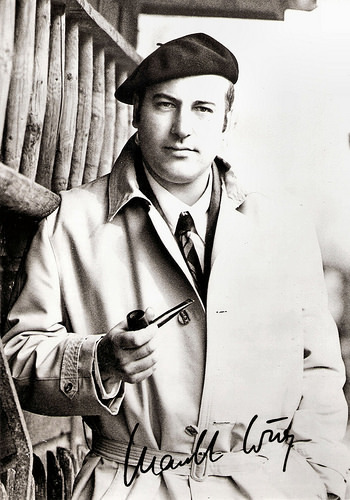
Big East-German card by VEB Progress Filmvertrieb, no. 155/70, 1970. Retail price: 0,20 DM. Photo: Linke.
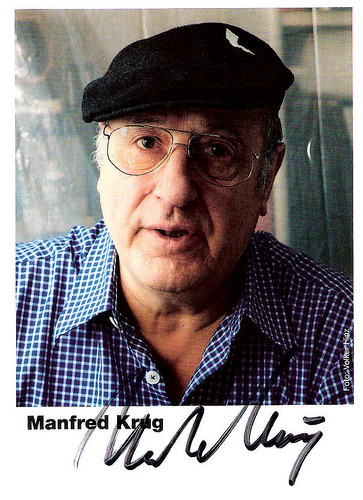
German promotion card by kv-events.de. Photo: Volker Hinz.
Trailer Spur der Steine/Trace of Stones (1966). Sorry, no subtitles. Source: DEFA-Stiftung (YouTube).
Trailer Feuer unter Deck/Fire below deck (1977). Sorry, no subtitles. Source: DEFA-Stiftung (YouTube).
Sources: Filmportal.de, AllMovie, Wikipedia (English and German) and .

East-German postcard by VEB Progress Filmvertrieb, no. 966, 1959. Retail price: 0,20 DM. Photo: DEFA / Dassdorf. Publicity still for Reportage 57 (János Veiczi, 1959).

German promotion card by Intercord, Stuttgart, 1979.
Powerful body language and rebellious presence
Manfred Krug was born in 1937 in Duisburg, Germany. His parents were Rudolf and Alma Krug. In 1949, after the divorce of his parents, the 13-years-old Manfred moved with his father from Duisburg to the newly founded German Democratic Republic (GDR). The young Krug trained as a steel smelter in Brandenburg an der Havel. A splash of liquid steel caused a distinctive scar on his forehead.
Krug worked for four years in a steel plant and rolling mill. In the evenings he studied and decided to go to drama school. From 1955 to 1957 he was an apprentice at Bertolt Brecht's Berliner Ensemble. In 1957, Krug made his film debut as a guitarist in Die Schönste/The most beautiful (Ernesto Remani, Walter Beck, 1957).
Filmportal.de : “Because of his strong build, his powerful body language, and his rebellious presence, Krug mainly played roles of villains and young rowdies in the early years of his movie career.” He played a smuggler in the crime film Ware für Katalonien/Goods For Catalonia (Richard Groschopp, 1959), based on a true fraud: a criminal sold the entire stock of optical instruments produced by the Zeiss factory in Jena, East Germany, to the Spanish Army and to customers in Barcelona.
Krug also appeared in the successful war film Fünf Patronenhülsen/Five Cartridges (Frank Beyer, 1960) opposite Erwin Geschonneck and Armin Mueller-Stahl . During the Spanish Civil War, a battalion of the International Brigades is cut off without water or ammunition. Five Cartridges won director Frank Beyer great acclaim, and also for Krug many more film roles followed. He also achieved notability as a jazz singer.
He appeared in the drama Professor Mamlock (Konrad Wolf, 1961) about a Jewish surgeon (Wolfgang Heinz) in Germany of the early 1930s. It was based on the play Professor Mamlock, written by the director's father Friedrich Wolf during 1933, when he was in exile in France.
Krug was often cast as the tough guy with a heart of gold, such as in Auf der Sonnenseite/On the Sunny Side (Ralf Kirsten, 1962). In this musical comedy he starred as a steel smelter and an amateur actor and jazz singer, who is sent to a drama school by his factory's committee. The film's script was largely inspired by Krug's biography: he worked in a steel factory before turning to an acting career. His jazz band and his singing career were also a central theme in the plot.
DEFA historian Dagmar Schittly notes that Auf der Sonnenseite was the most popular East German film of the early 1960s, and Krug and the collective crew were awarded the Heinrich Greif Prize for their work. Krug managed to give the Communist system a human face and credibility. Krug and director Kirsten reunited for the historical adventure Mir nach, Canaillen!/Follow Me, Scoundrels (Ralf Kirsten, 1964).
Two years later Krug starred in Spur der Steine/Trace of Stones (Frank Beyer, 1966). After its release, the film was shown only for a few days, before being shelved due to conflicts with the Socialist Unity Party, the ruling communist party in the GDR. Krug’s portrayal of a rebellious and brash building site brigadier was deemed as too ‘anarchic’ by the censors.
Filmportal.de : “Indeed, the role of the aggressive, yet down-to-earth worker who defies authority and often kicks over the traces has always been one of Krug's main roles.” Only after 23 years was the film shown again, in 1989, when the Berlin Wall fell.
His other DEFA-films include Die Fahne von Kriwoj Rog/The Banner of Krivoi Rog (Kurt Maetzig, 1967) starring Erwin Geschonneck, and the contemporary Eastern road movie Weite Straßen – stille Liebe/ Wide streets, silent love (Herrmann Zschoche, 1969) with Jaecki Schwarz , which made Krug a favourite among East-German teenage filmgoers.

East-German postcard by VEB Progress Filmvertrieb, no. 1.819, 1963. Retail price: 0,20 DM. Photo: Klaus Fischer. Publicity still for Revue um Mitternacht/Midnight Review (Gottfried Kolditz, 1962).

East-German postcard by VEB Progress Filmvertrieb, no. 88/69. Photo: DEFA / Wenzel. Publicity still for Hauptmann Florian von der Mühle/Captain Florian of the Mill (Werner W. Wallroth, 1968).

East-German postcard by VEB Bild und Heimat Reichenbach i.V., no. AG 500/12/72. Photo: DEFA / Kroiss. Publicity still for Die gestohlene Schlacht/The stolen battle (Erwin Stranka, 1972) with Herwart Grosse.
Pushed off
In 1976 Manfred Krug participated in protests against the expulsion and stripping of GDR citizenship of singer-songwriter Wolf Biermann. Suddenly the popular Krug, who had won numerous awards in the years before (among them the National award and the Medal for Merit of the GDR), was subjected to sanctions and censorship. The situation escalated when Krug beat down a Stasi informer who had insulted and defamed him publicly.
After six months of partly unemployment, Krug requested to leave the GDR in 1977. As soon as he got the approval he left East-Germany and moved to Schöneberg in West Berlin. Twenty years later, he wrote about these events in his book Abgehauen (1997, Pushed off). This memoir became a bestseller and in was filmed by Frank Beyer in 1998.
After moving back to West Germany, Manfred Krug very soon got new roles. In 1978 he appeared as the adventurous truck driver Franz Meersdonk in the TV series Auf Achse/On the Axis. He continued to play in the series until 1995, one year before the show ended its long run. Krug's various television roles even included a two-year stint on the children's program Sesamstraße (1982-1984), the German version of the American children's program Sesame Street.
He was very popular as an attorney in the Berlin-based comedic attorney TV series Liebling Kreuzberg/Darling Kreuzberg (1986-1998). From 1984 till 2001, he also starred as Hamburg-based commissioner Paul Stoever in the Krimi series Tatort, which would eventually run for a total of 41 instalments.
His later feature films include the comedy Neuner (Werner Masten, 1990), and the political drama Der Blaue/The Blue One (Lienhard Wawrzyn, 1994), which was entered into the 44th Berlin International Film Festival. In 2005, his second memoir, Mein schönes Leben (2005, My beautiful life), became another bestseller.
Since 1963, Manfred Krug is married with Ottilie Krug. Together they have three children, including the singer Fanny Krug. In 2002 it was announced that Manfred Krug has also an illegitimate child. Krug lives in Berlin-Charlottenburg.

Big East-German card by VEB Progress Filmvertrieb, no. 155/70, 1970. Retail price: 0,20 DM. Photo: Linke.

German promotion card by kv-events.de. Photo: Volker Hinz.
Trailer Spur der Steine/Trace of Stones (1966). Sorry, no subtitles. Source: DEFA-Stiftung (YouTube).
Trailer Feuer unter Deck/Fire below deck (1977). Sorry, no subtitles. Source: DEFA-Stiftung (YouTube).
Sources: Filmportal.de, AllMovie, Wikipedia (English and German) and .
Published on October 10, 2016 22:00
Paul van Yperen's Blog
- Paul van Yperen's profile
- 13 followers
Paul van Yperen isn't a Goodreads Author
(yet),
but they
do have a blog,
so here are some recent posts imported from
their feed.



